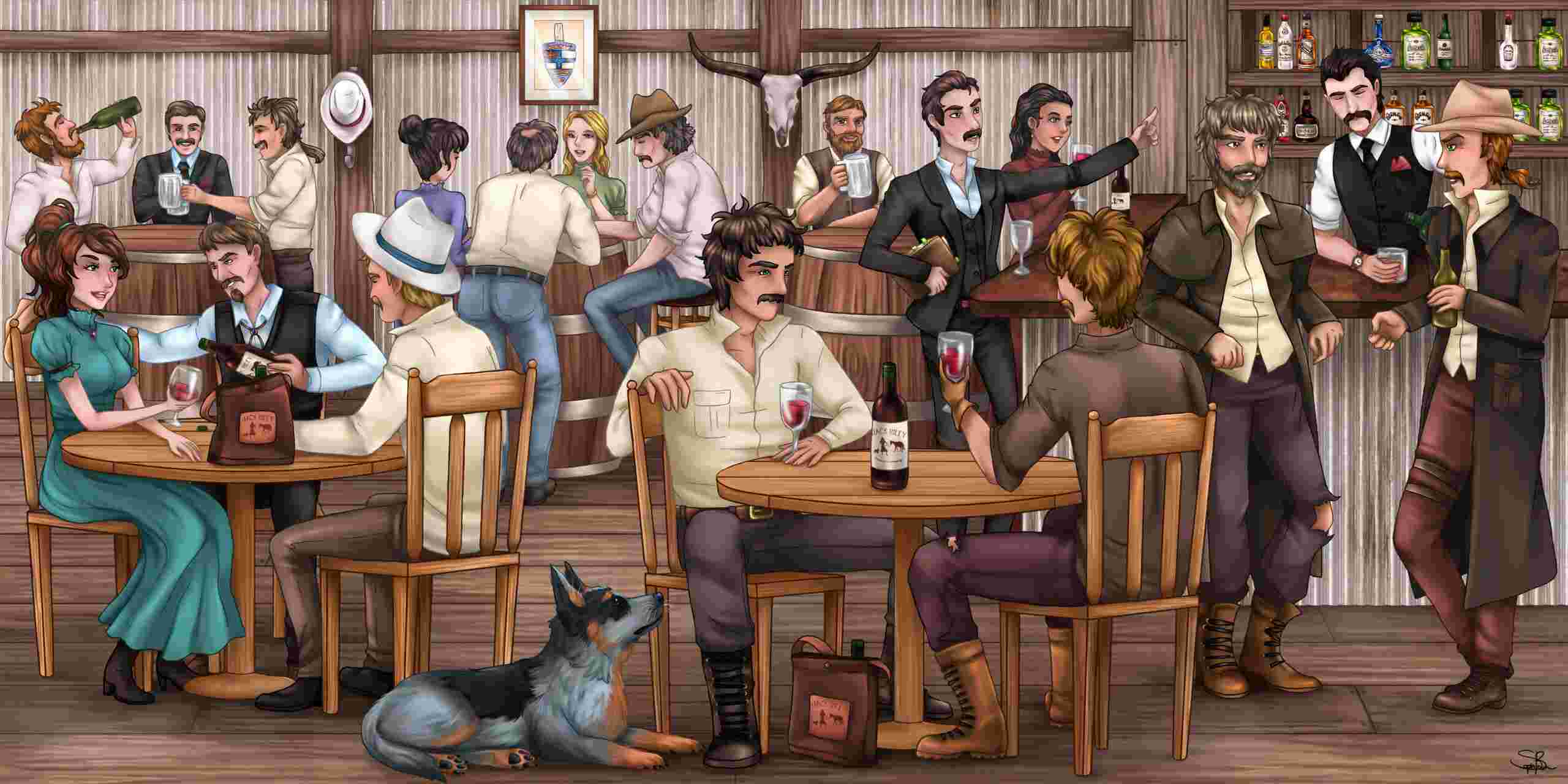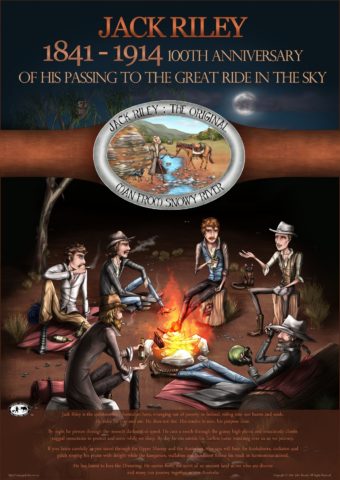The history of Jack Riley: the original man from Snowy River
history of Jack Riley: the original man from Snowy River
Story and Ballad by John Bacash Ⓒ2021 Jacques Byark P/L
Scene 1

The Story of Jack Riley
Imagine life in Castlebar, in County Mayo, for the very young Jack Riley, who’d been born in 1841, before the Irish potato famine hit. His life was full. His parents were tailors and they kept some horses. In fact, it was said that Jack could ride before he could walk. On weekends and holidays, Jack visited his cousins in the idyllic countryside, with its rolling hills, verdant valleys and fields, stretching as far as the eye could see. And he listened in fascination to local myths and tall stories of adventure on the high seas. This awoke a love of good yarn in Jack, and a thirst for adventure that was to make his name famous, years later in Australia. The seed was sown.
The Ballad of Jack Riley
This is the ballad of Jack Riley: the original man from Snowy River, the high-country horseman who encountered the seven horsemen of the apocalypse on his way to becoming an Australian legend.
Riding high and dancing low in pre-famine Ireland
Times of bounty and plentifulness
Riding high and dancing low
Times of acceptance and togetherness
Riding high and dancing low
Cousins and neighbours play in the moment care free of distinctions
He rides for you, and he rides for me
He rides for you, and he rides for me
Events
Scene 2
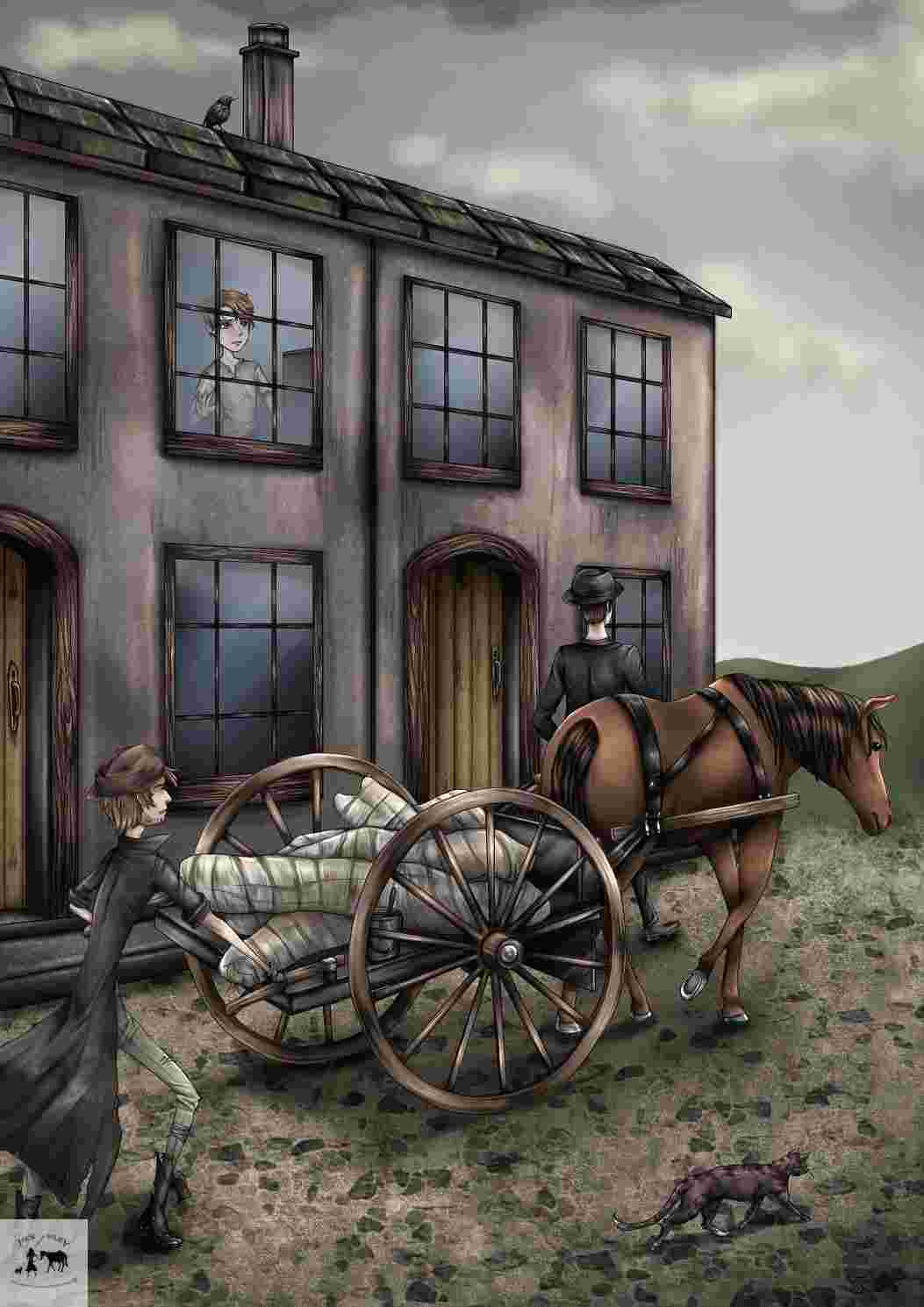
The Story of Jack Riley
Jack was just 4 years old in 1845, when the potato famine hit Ireland, with County Mayo one of the worst areas affected. While he found the devastation and trauma hard to understand, Jack was horrified to see the corpses of his cousins being carted away to be buried. He remembered playing with those cousins without a care in the world not so long ago. Jack didn’t realise that his cousins’ family rented a few acres from an English landlord. There they grew potatoes and relied on those for food – and to pay their way in life. When the late blight disease hit, they had no food. No money. And no hope. They were forced to leave the land because they couldn’t pay the rent. The way seemed dire.
The Ballad of Jack Riley
The first horseman of the apocalypse: Death
Death comes rolling in
Like a dark cloud blocking out the light
Death comes rolling in
Like a grim reaper slashing Jack’s might
Death comes rolling in
Burying Jack’s soul.
Death comes rolling in
Taking a heavy toll
He rides for you, and he rides for me
He rides for you, and he rides for me
Events
Dora Dora Station, Table Top Mountain Massacre
| Site Name | Dora Dora Station, Table Top Mountain |
| Victims | 12 Aboriginal People killed |
| Attackers | 0 Colonists killed |
| Date range | Between 1836-01-01 and 1836-12-31 |
| Language Group | Wiradjuri |
Tambo Crossing Massacre
| Site Name | Tambo Crossing |
| Victims | 70 Aboriginal People killed |
| Attackers | 0 Colonists killed |
| Date range | Between 1843-11-01 and 1844-06-01 |
| Language Group | Tatungalung or Brabralung |
Scene 3
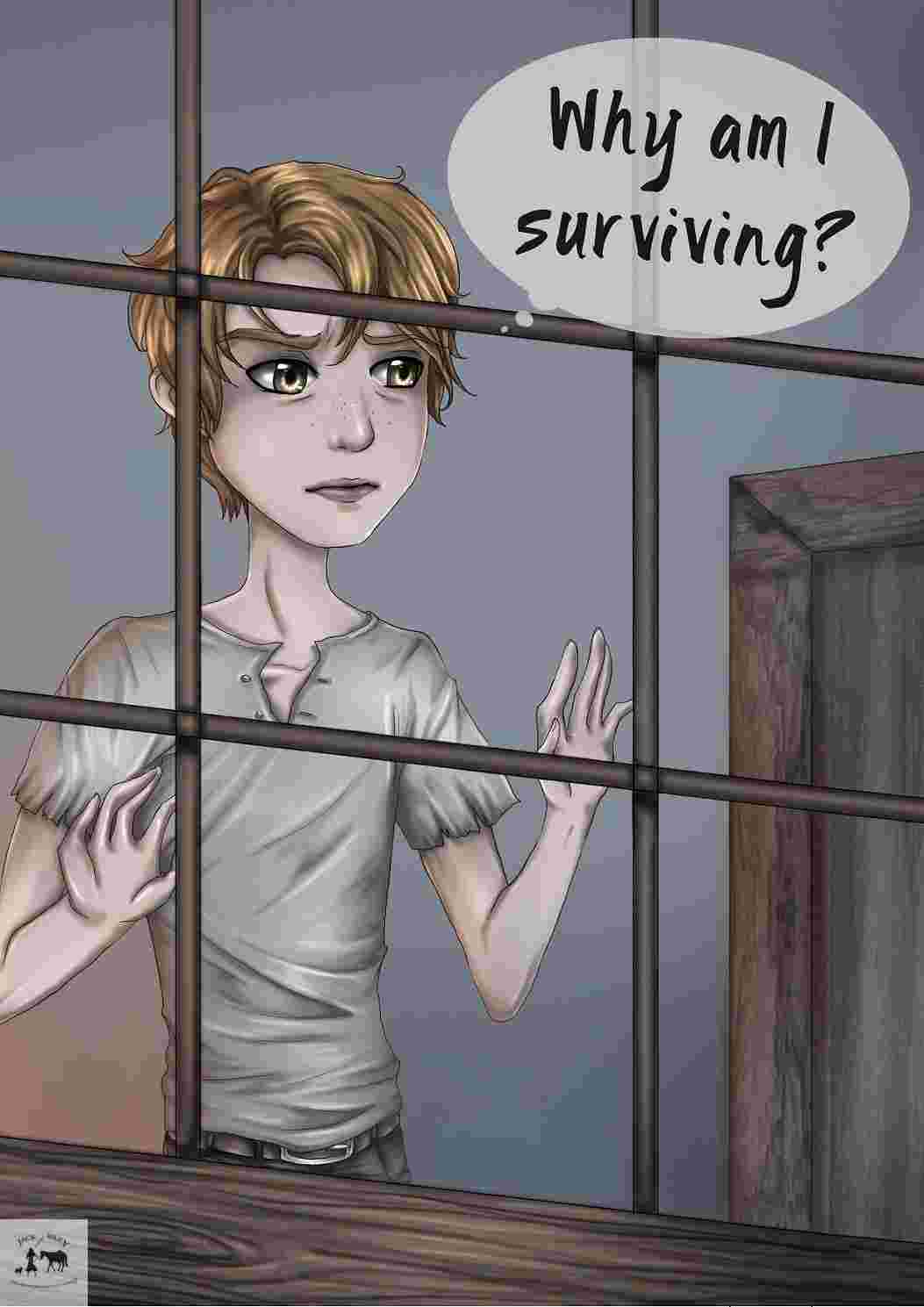
The Story of Jack Riley
Things got worse for his neighbours and the people of County Mayo, and Jack became troubled. While Jack’s family eked out a living with their tailoring business, the famine was taking countless lives in horrendous circumstances. Jack started to question why he was well when so many people were starving to death around him. “Why am I surviving?” he thought, and his guilt was overwhelming. This made an indelible impression on him that he carried for most of his life. His thoughts took him down.
The Ballad of Jack Riley
Death comes rolling in
Death and loss forever complicating
Death comes rolling in
Complicating Jack’s mind
Death comes rolling in
Death and loss forever complicating
Death comes rolling in
Breaks Jack open to his question:
Why am I surviving?
He rides for you, and he rides for me
He rides for you, and he rides for me
Events
Snowy River Massacre
| Site Name | Snowy River |
| Victims | 15 Aboriginal People killed |
| Attackers | 0 Colonists killed |
| Date range | Between 1846-12-16 and 1846-12-16 |
| Language Group | Tatungalung or Krauatungulu |
Scene 4
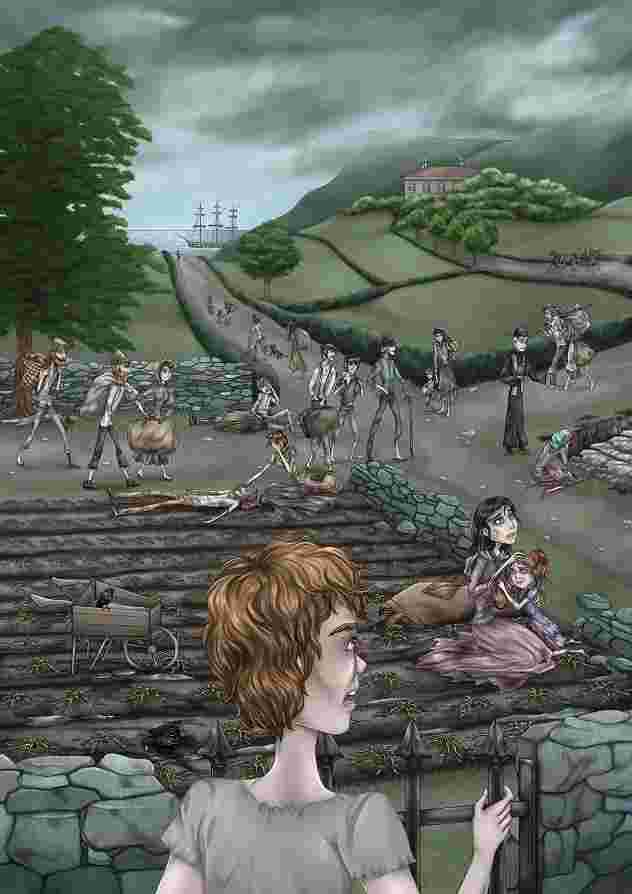
The Story of Jack Riley
The situation was dire. Bodies lay in barren fields, in the streets, in the town. The famine was heartless. It was destroyed with impunity. Jack saw unbelievable suffering that he never forgot. The heartrending cries of those dying of starvation seared into his soul. Some were sent abroad to the New World (America), Canada, and Australia if they were able to travel. Those barely alive besieged the doors of the poor houses, wanting a place to die where they might be buried in a coffin. They were little more than terrified, shivering skeletons, and there was no hope of food, for the funds had dried up. He saw people expire.
The Ballad of Jack Riley
Death comes rolling in
It feels like death to Jack
Death comes rolling in
Surviving how?
Death comes rolling in
Jack feels like the walking dead
Death comes rolling in
Surviving for what?
Death comes rolling in No purpose to assume
Death comes rolling in
Surviving with whom?
Death comes rolling in
Cousins and friends are gone.
He rides for you, and he rides for me
He rides for you, and he rides for me
Events
Milly, Brodribb River Massacre
| Site Name | Milly, Brodribb River |
| Victims | 15 Aboriginal People killed |
| Attackers | 0 Colonists killed |
| Date range | Between 1850-01-01 and 1850-12-31 |
| Language Group | Krauatungulung |
The Slaughterhouse Massacre
| Site Name | The Slaughterhouse |
| Victims | 15 Aboriginal People killed |
| Attackers | 0 Colonists killed |
| Date range | Between 1850-01-01 and 1850-12-31 |
| Language Group | Tatungalung or Brabralung |
Scene 5
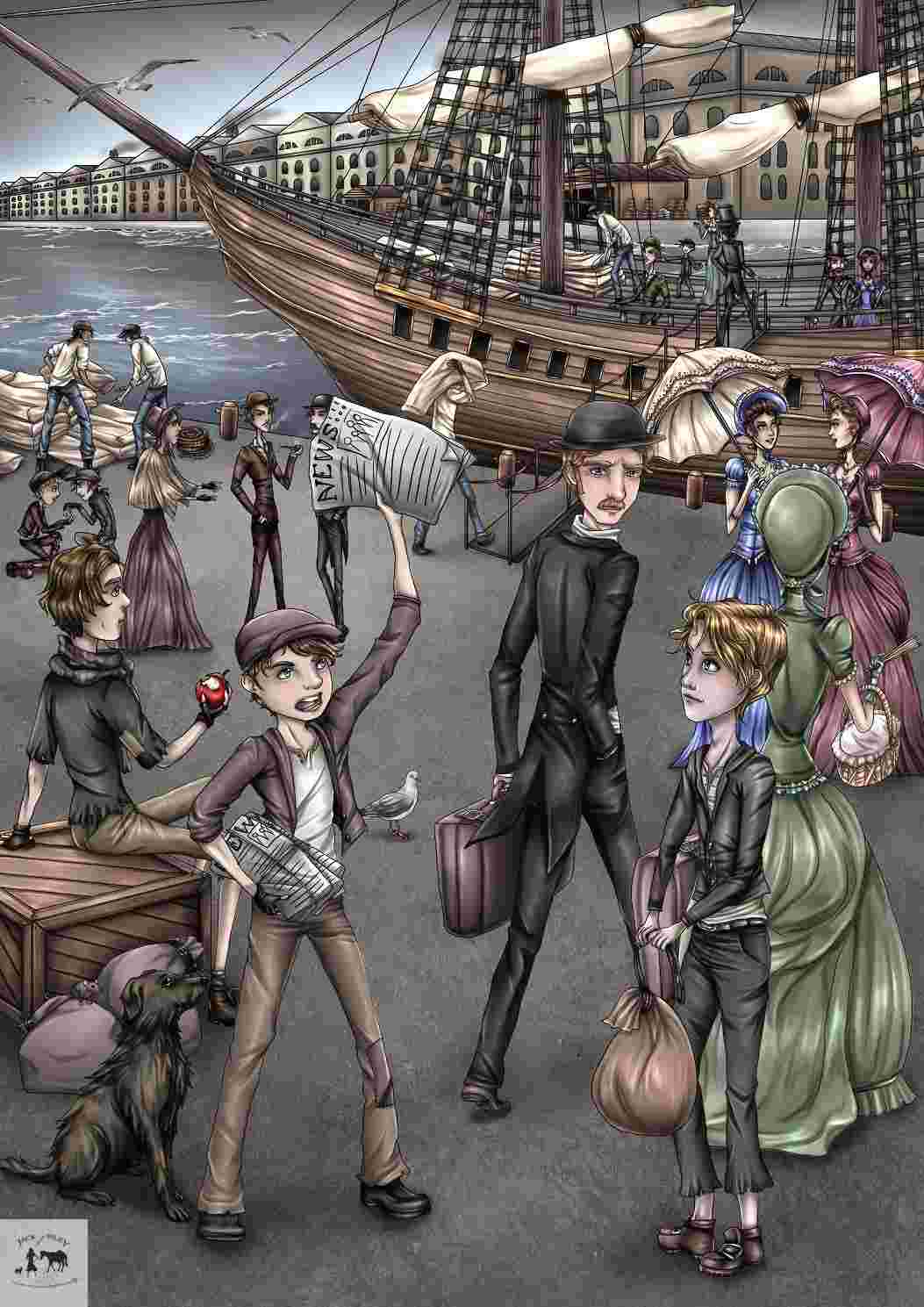
The Story of Jack Riley
In 1854, when Jack was just 13, his parents sent him to Australia on an assisted passage aboard the ship ‘Rodney’ to join his sister, Mary Anne. Jack wasn’t fazed by the fact that he’d be travelling alone. After all, there were many people sailing to Australia on the Rodney. Jack’s mind was full of the adventure that lay before him, which he hoped would help him to let go of the torment he felt about the famine. He fantasised about the ship’s tales he’d heard as a boy, and he grew more excited as he went to board the ship. His hopes were high.His expectations were set.
The Ballad of Jack Riley
The second horseman of the apocalypse: the temptation to play God by assuming knowledge of good and evil
Death comes rolling in
Australia becomes the good place to be –“The Answer” to death and dying.
Death comes rolling in
Ireland becomes the bad place- “The Problem” and the cause of death and dying.
Death comes rolling in
Acting out this judgement, Jack leaves Ireland in an anxiously blinkered rush.
He rides for you, and he rides for me
He rides for you, and he rides for me
Events
The Crimean War: 1853 to 1856 Eureka Stockade: 3 December 1854
Scene 6
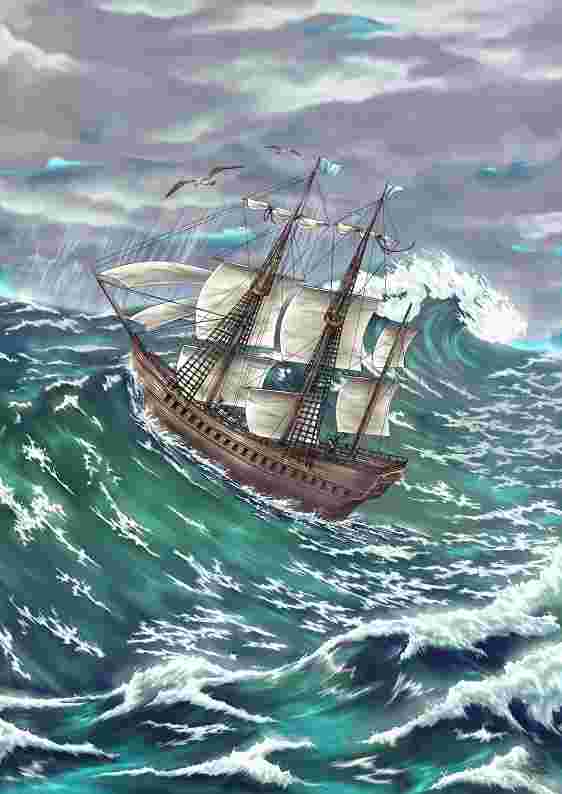
The Story of Jack Riley
The Rodney had sailed from County Cork to Southampton, to take on more passengers. Then it sailed down the west coast of Africa, around Cape Horn, and through the Roaring Forties. Nothing had prepared Jack for the rough voyage, the rough sailors or the rough and tough captain. The ship pitched wildly through massive seas around Cape Horn. Jack was terrified more times than he could remember, thinking each moment might be his last. The food was terrible. The other passengers were ill, and scared. Jack’s tiny straw bunk bed was in steerage – below the waterline – without light or ventilation, and hygiene was poor. But Jack was nothing if not resourceful, his Irish spirit keeping him from giving up. After almost 12 weeks, the Rodney sailed into Sydney Harbour. But it was tough.
The Ballad of Jack Riley
Waves of reality come crashing in
Waves crashing in
Waves of reality come crashing in
Testing hope in false hopes
Waves of reality come crashing in
No resting in the hull
Waves of reality come crashing in
No ma and da to protect Jack from bullying villains
Waves of reality come crashing in
No sunlight either
Waves of reality come crashing in
Waves keep crashing in
He rides for you, and he rides for me
He rides for you, and he rides for me
Events
For those who travelled to Australia in the nineteenth century, the journey was often long and dangerous. Life at sea was uncomfortable and often hazardous, particularly for passengers who travelled cheaply in steerage (the lowest deck and below the waterline). Storms were common in the Southern Ocean, but they were not the only danger. Hygiene was poor at the best of times and worse in bad weather. ‘Batten-down the hatches’ meant passengers on the lowest deck were confined without ventilation or light in conditions that were ideal for the spread of disease. The use of candles or oil lanterns was restricted and sometimes forbidden – cramped conditions with timber, straw mattresses, hemp (rope), and tar caulking meant a fire could spread with terrifying speed. A disaster at sea or shipwreck on the coast left little hope for rescue – few sailors or passengers could swim, and there were rarely enough lifeboats for the numbers on board.
Scene 7
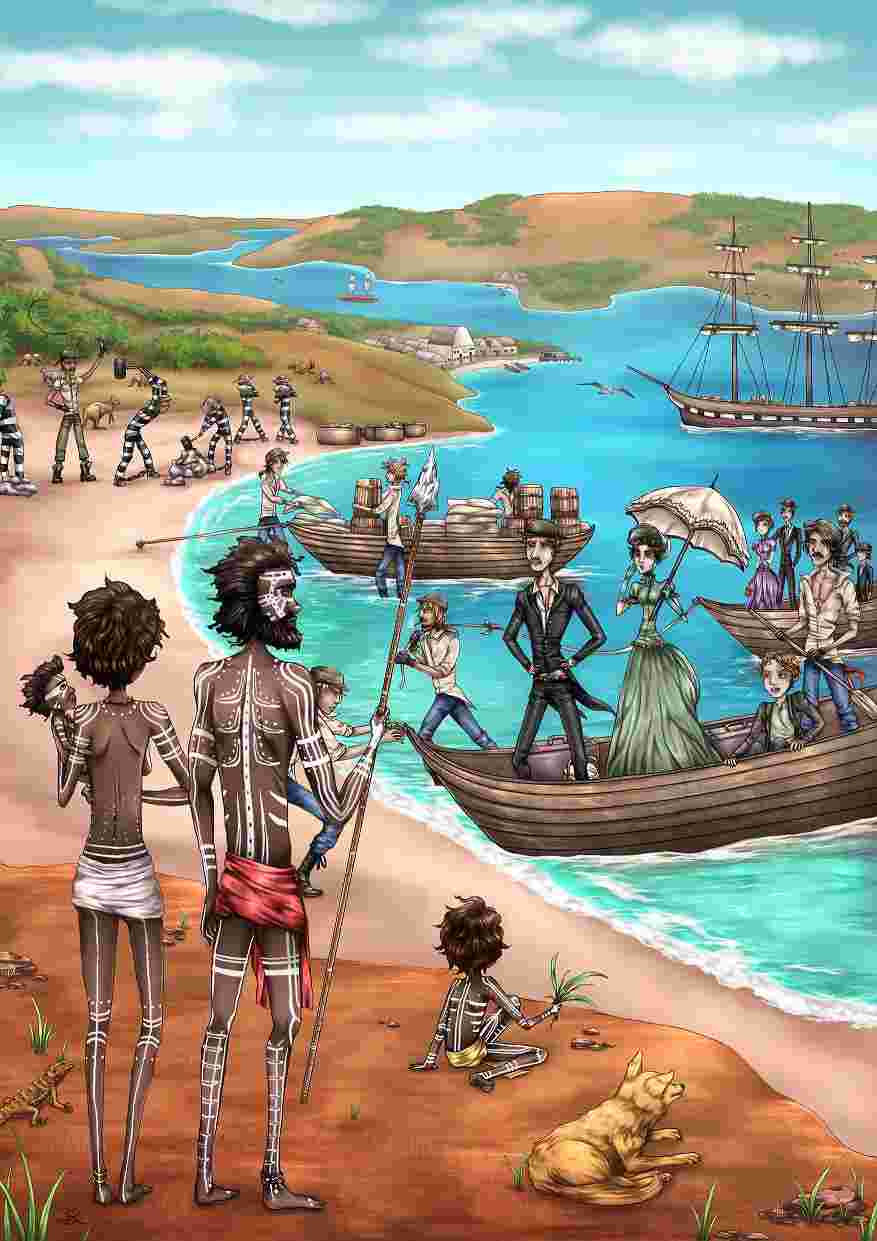
The Story of Jack Riley
Jack and the other passengers were ferried to the shore in small boats. Jack was astounded by the dryness of the land, the blue sky, the heat, and the flies. It all looked so strange to him. But after his voyage, he was thankful to be in the fresh air. He had to find his sister, who was in Berrima, 85 miles away. Ever resourceful, Jack set off for Berrima, thankfully sleeping in beds above ground, but facing nights plagued with mosquitoes. Days later he arrived at his sister’s place, where she lived with her husband, Joseph Jones. They’d married in 1950. By the time Jack reached Berrima, he was sunburnt, sore and stiff – but ready to embrace his new life.
The Ballad of Jack Riley
Waves of reality come crashing in
Testing time
Waves of reality come crashing in
Testing hope against hope
Waves of reality come crashing in
Jack wonders: Am I pretending?
Waves of reality come crashing in
Dark people, Dry land sunburnt skin
Waves of reality come crashing in
Walking to Berrima, hitching a ride
He rides for you, and he rides for me
He rides for you, and he rides for me
Events
Scene 8
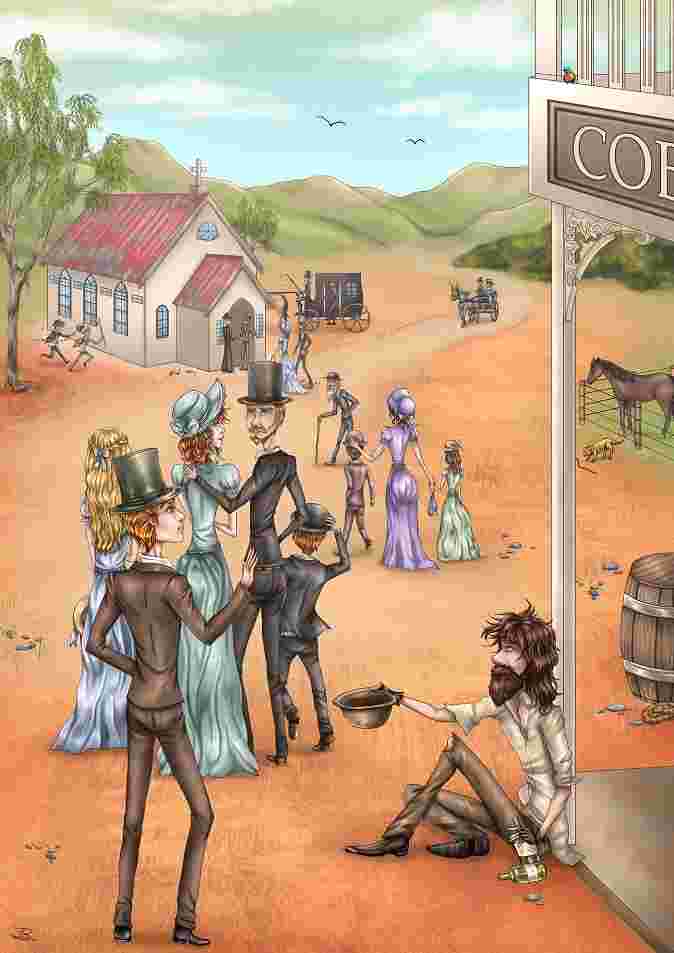
The Story of Jack Riley
Jack soon discovered that the church, which always cared for the poor, was frequented by Australians who were doing it tough. However, Jack had no time for those who were down on their luck. People on their way to church passed by a poor man begging. Jack held his head high and averted his eyes. He was disidentified with the suffering of others as a defence against owning his trauma. He looked down on those facing hardship. To Jack, there was no such thing as love thy neighbour. The poor were in a class of their own, and they were harshly judged by those who considered themselves better. Although Jack had seen unspeakable suffering, he did not allow himself to feel bad for the man who was begging. And he was puzzled by the generosity of the local priest towards that man, and to others like him.
The Ballad of Jack Riley
Waves of reality come crashing in
Beggars don’t pretend
Waves of reality come crashing in
The begging-drunk is not pretending
Waves of reality come crashing in
The beggar is grounded
Waves of reality come crashing in
Confronting Jack on his way to church
Waves of reality come crashing in
Drawing out Jack’s pretending
Waves of reality come crashing in
Jack’s chin goes up, Jack’s arse is tight
Waves of reality come crashing in
Jack’s hand is raised to halt the confronting energy from the ground; the Top Hat tilts up and back
And so Jack encounters the third horseman of the apocalypse: arrogance
He rides for you, and he rides for me
He rides for you, and he rides for me
Events
Scene 9
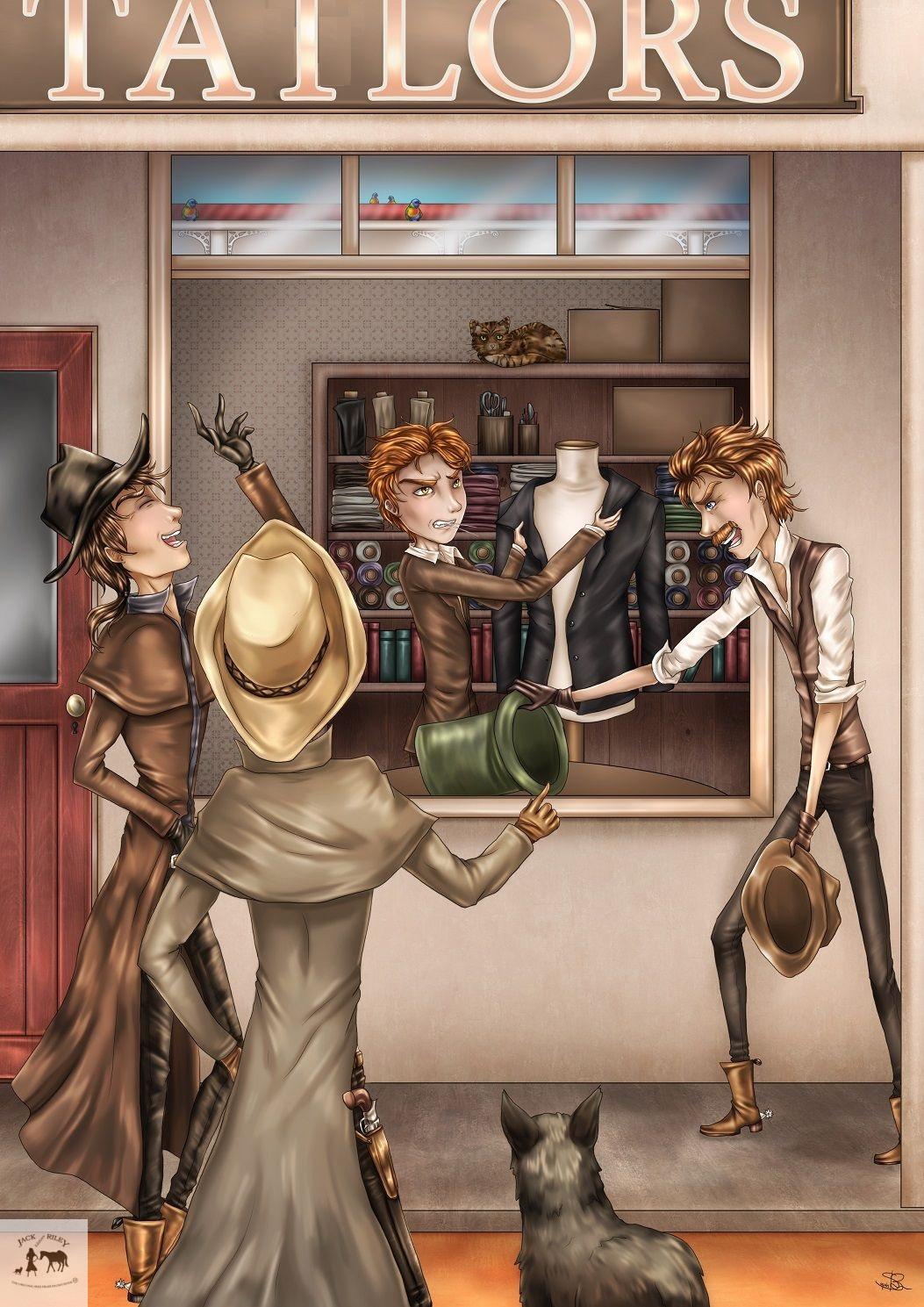
The Story of Jack Riley
Jack’s sister and her husband, Joseph Jones, had two little girls, Maria and Louisa. They were Jack’s first nieces and he was devoted to them. When Joseph Jones died, Mary Anne, Maria, Louisa, and Jack moved to Omeo, where Jack supported them through a tailoring business. His exacting work and flair for the tailored fashions of the day, as well as his immaculate dress, earned him many taunts by the locals. They gathered outside, laughing, pointing at him, and jeering. Finally, Jack had enough and decided to teach a particularly nasty man a lesson.
The Ballad of Jack Riley
Waves of reality keep crashing in
Taunting locals
Waves of reality keep crashing in
Spoil the delusion of safety at home
Waves of reality keep crashing in
Breaking through the well-dressed façade
Waves of reality keep crashing in
Then Jack erupts in fury
Waves of reality keep crashing in
All pretence and façade soon to vanish
He rides for you, and he rides for me
He rides for you, and he rides for me
Events
In the 1850s, Omeo was a gold mining town on the Eastern side of the Alps. It was a place for high country stockmen to get supplies and have a bed, beer, and breakfast at The Golden Age Hotel. Jack’s tailoring shop was opposite the Golden Age Hotel.
Scene 10
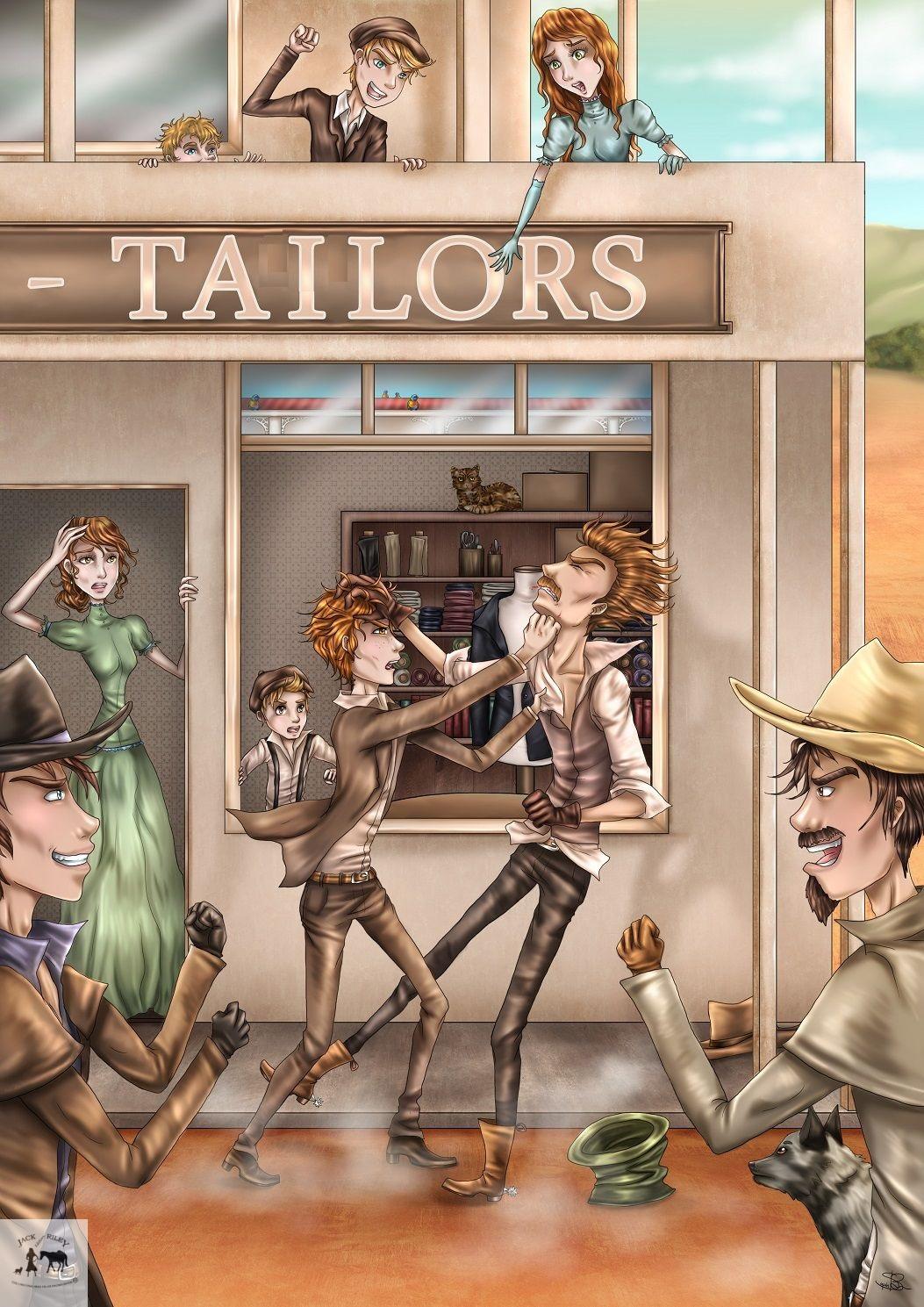
The Story of Jack Riley
He threw the first punch and knocked that mocking man to the ground, to the astonishment of those looking on. Punch after punch he rained upon his protagonist, and the fight drew a crowd, in typical Aussie fashion. They watched the underdog take his revenge, regardless of his tailored clothes. Jack was in fine fighting form. He’d gone through unbelievable horrors, and the fight was cathartic. Dishevelled and rumpled, Jack rained blows on his opponent in a fierce onslaught, his honour at stake.
The Ballad of Jack Riley
Waves of reality keep crashing in
Breaching Jacks defences
Waves of reality keep crashing in
Years of pent-up anger released
Waves of reality keep crashing in
Strangely soothing
Waves of reality keep crashing in
Jolting erupting fist of fury from a conflict once buried and forgotten
Waves of reality keep crashing in
Jolting erupting fist of fury from a sense of sadness and loss long forgotten
Waves of reality keep crashing in
Now that forgotten thing is a clear and present danger to Jack and to others yet surprisingly invigorating and assuring.
He rides for you, and he rides for me
He rides for you, and he rides for me
Events
Scene 11
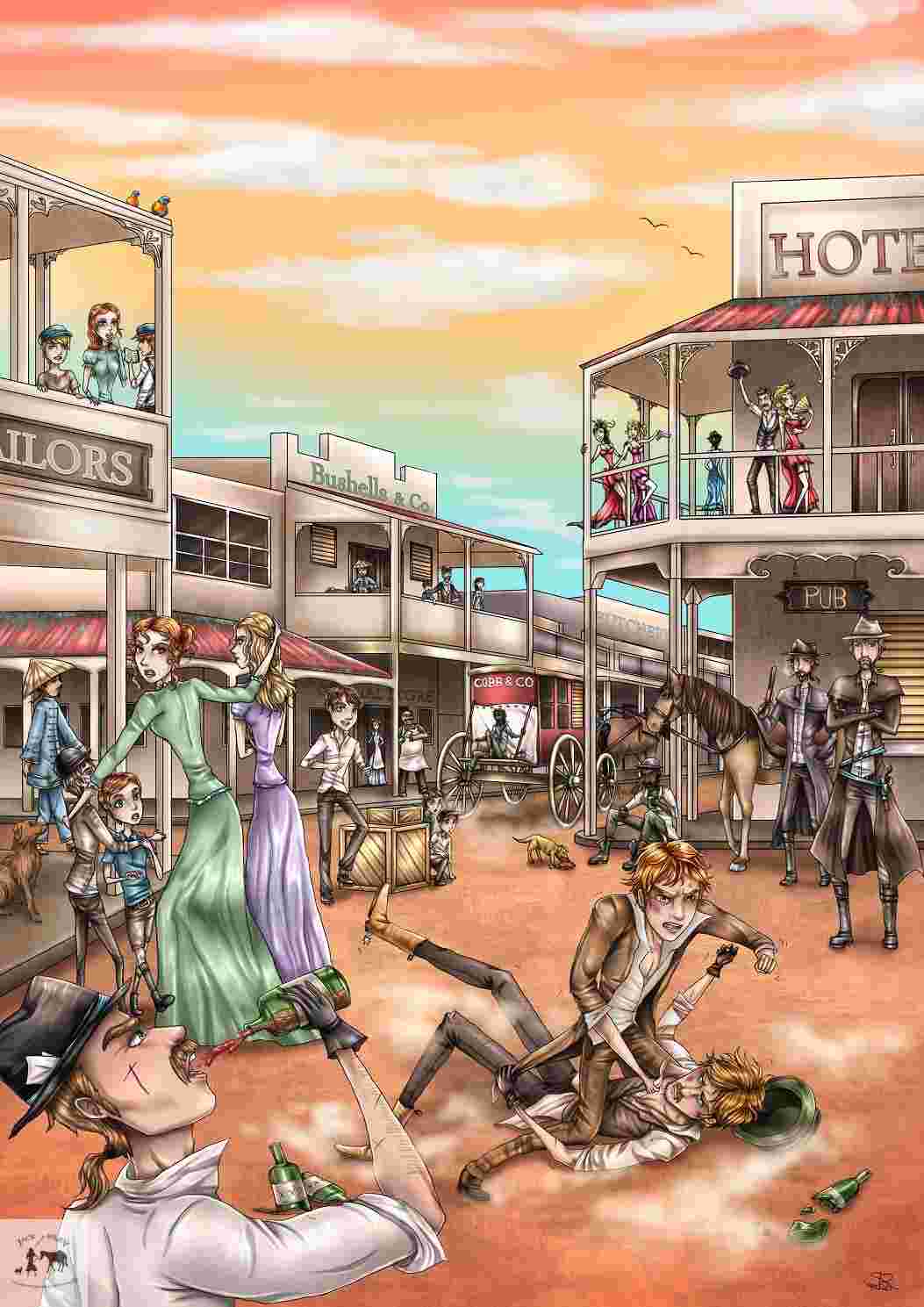
The Story of Jack Riley
By now the crowd had swelled. People could not believe that tailor Jack had such a fighting spirit. They loved seeing him give that jeering, taunting man his just desserts. Eventually, Jack knocked him down and, to add insult to injury, rained blows upon his face. The crowd was amazed. In front of their eyes, pint-sized Jack had acquitted himself against a much taller man, fighting for his rights. Little did Jack know that proving himself like this was going to be a turning point of his acceptance by the locals.
The Ballad of Jack Riley
Drawing in the crowd
Mesmerised by the show of raw emotion
Drawing in the crowd
Fight! Fight! Fight! they chant
Drawing in the crowd
The fight frees them from their deadening veneer of civility
Drawing in the crowd
A living moment of truth breaking through each individual’s comfort zone hitherto held onto so proudly.
He rides for you, and he rides for me
He rides for you, and he rides for me
Events
Scene 12
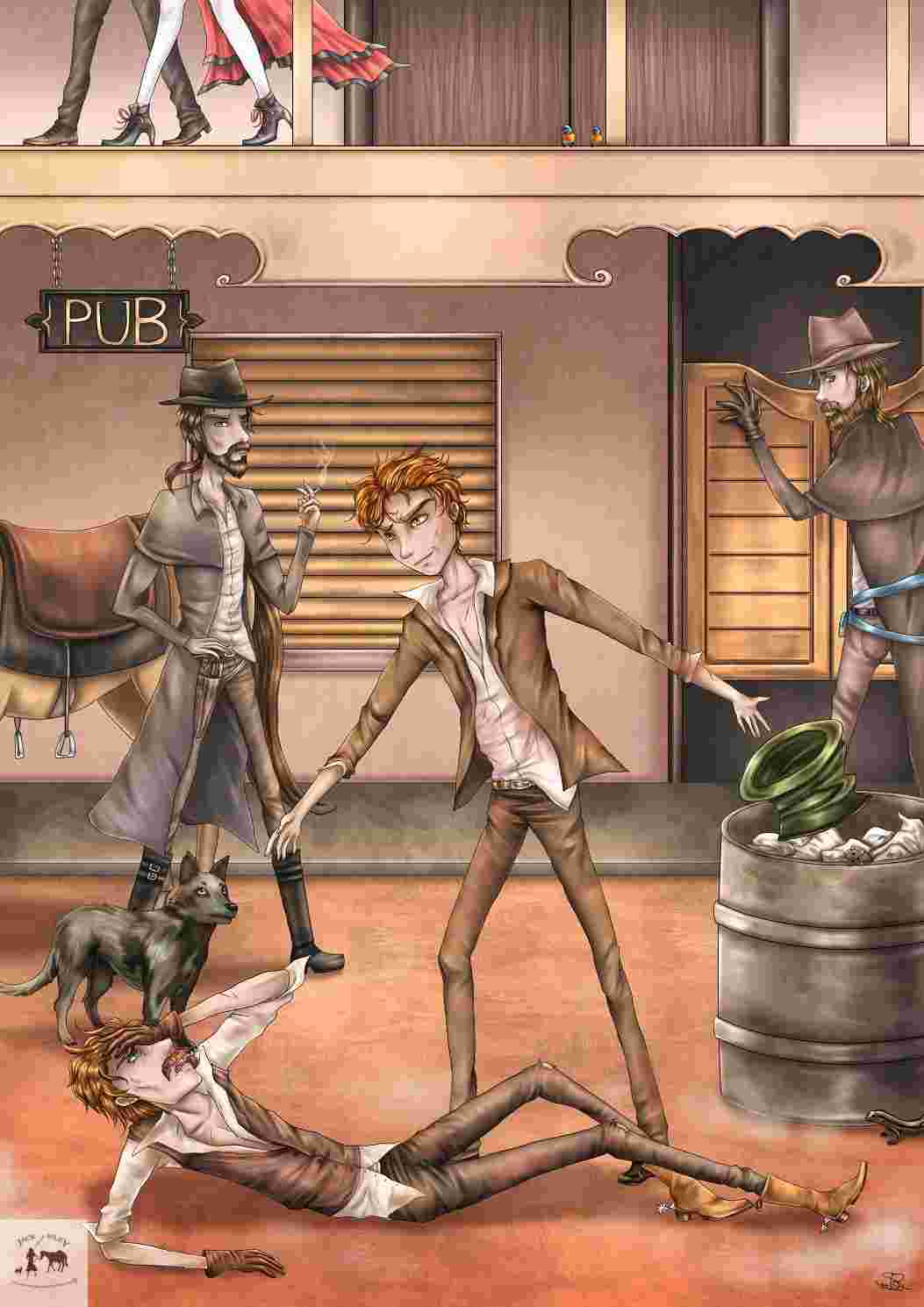
The Story of Jack Riley
But Jack was nothing if not a gentleman. Extending his hand to his opponent, he gracefully helped him up, and they bonded after their fight. No more taunts. No more jeering and laughing. Jack cemented himself with the locals through his courage and fighting spirit. They were amazed that he took down his opponent with such bravery and with no regard for his own fine clothes. In fact, Jack’s clothes were torn and dirty, but his spirit soared. During the weeks that followed that fight, his tailoring business increased dramatically. And the respect he earned initiated him into Australian society – the society of mateship.
The Ballad of Jack Riley
Resetting; Jack extends his hand in friendship
Civility returns
Resetting; the spectators resume their familiar roles
Blending back into conformity and anonymity
Resetting; the fight serves as a
Rite of Passage to mateship and belonging
Jack is now a local
Resetting; everyone returns to normality and civility
He rides for you, and he rides for me
He rides for you, and he rides for me
Events
Scene 13
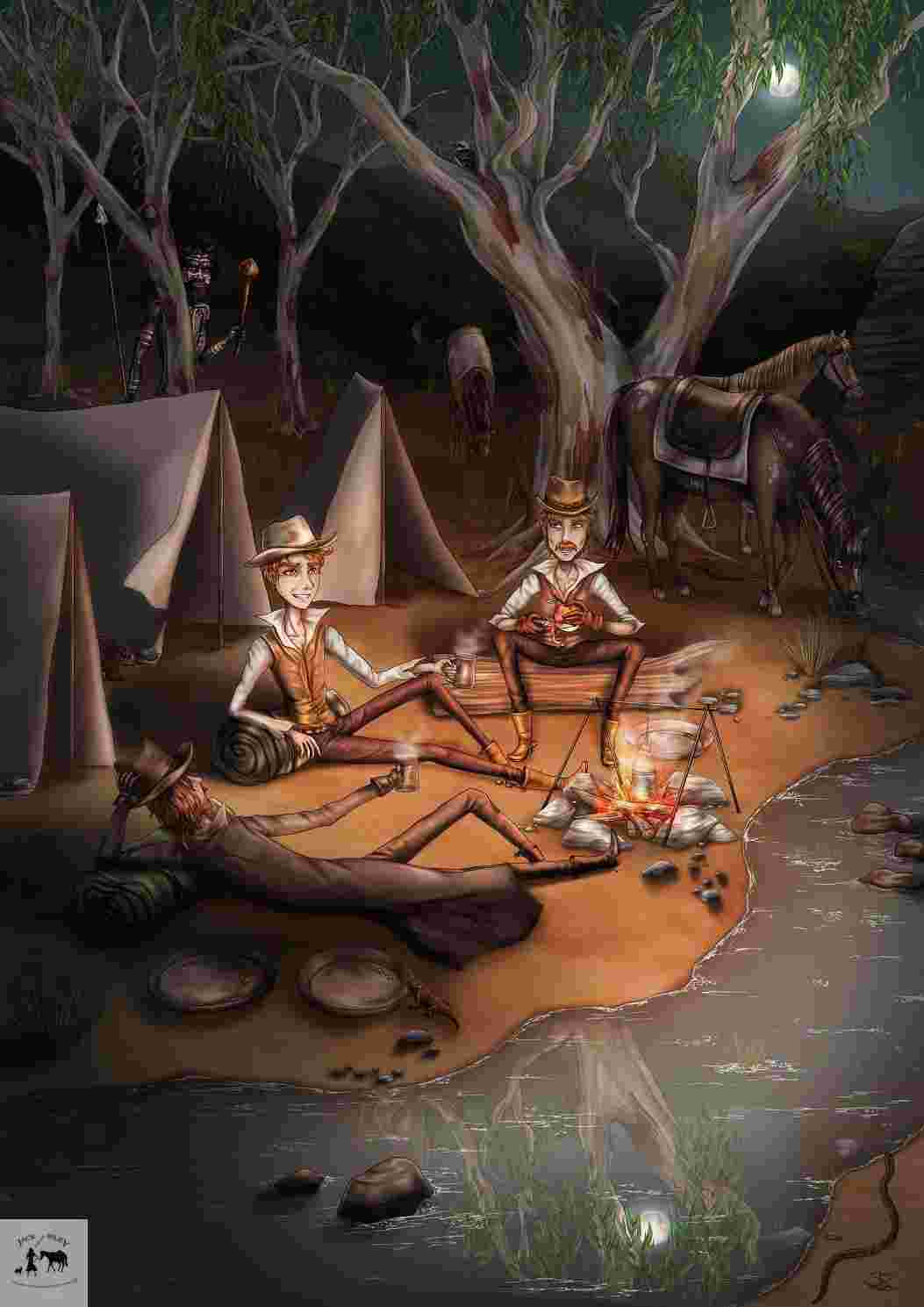
The Story of Jack Riley
Jack and his mates used to ride into the bush and set up tents made of tarpaulin. Then they’d sit around a campfire, boiling the billy. And yarning. Telling tall tales. Jack had plenty of those. He prefaced them all with “See here, now”. And he did that for the rest of his life. He told them about his early life, the famine, and the trip out. This way of life suited Jack to a t. The bush with its gum trees, rippling streams and ferns tugged at his heart. He felt completely at home.
The Ballad of Jack Riley
Speaking shit, keeping the vibe going
Mateship reigns supreme
Speaking shit, keeping the vibe going
Never let the truth stand in the way of a good story
Speaking shit, keeping the vibe going
The Irish blarney is set free
Speaking shit, keeping the vibe going
Jack finds his voice over a rum or two
Speaking shit, keeping the vibe going
Careful not to offend, deleting facts
Speaking shit, keeping the vibe going
Getting drawn into the clique
He rides for you, and he rides for me
He rides for you, and he rides for me
Events
| Year | Winner of the Melbourne Cup |
| 1861 | Archer |
| 1862 | Archer |
| 1863 | Banker |
| 1864 | Lantern |
| 1865 | Toryboy |
| 1866 | The Barb |
| 1867 | Tim Whiffler |
| 1868 | Glencoe |
| 1869 | Warrior |
Scene 14
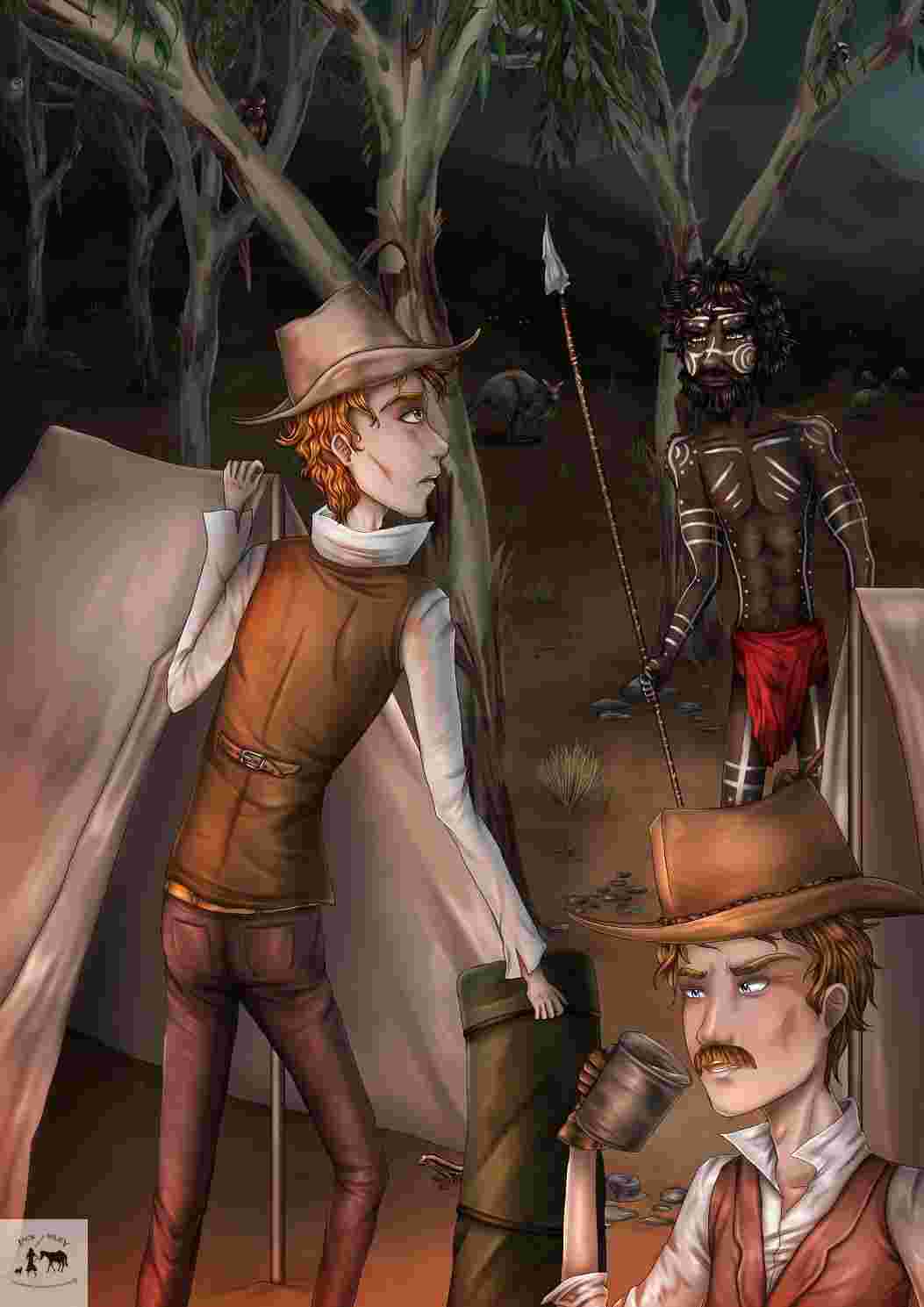
The Story of Jack Riley
Once when Jack was camping out with his mates, he was startled when an aboriginal appeared, seemingly out of nowhere. A bit like the scene in Crocodile Dundee where David Gulpilil appears. His body and face were covered in stripes of ash. He carried a spear, but he wasn’t threatening. He seemed to be wondering what Jack and his mates were doing there – just observing them. His mates reassured Jack that all was well and there was nothing to fear. The aboriginal disappeared silently into the bush. But it left Jack wondering who these aborigines were.
The Ballad of Jack Riley
Emerging out of the earth comes this original man
Not speaking shit
Emerging out of the earth comes this original man
Someone real, not part of the clique
Emerging out of the earth comes this original man
Spooking Jack
He rides for you, and he rides for me
He rides for you, and he rides for me
Events
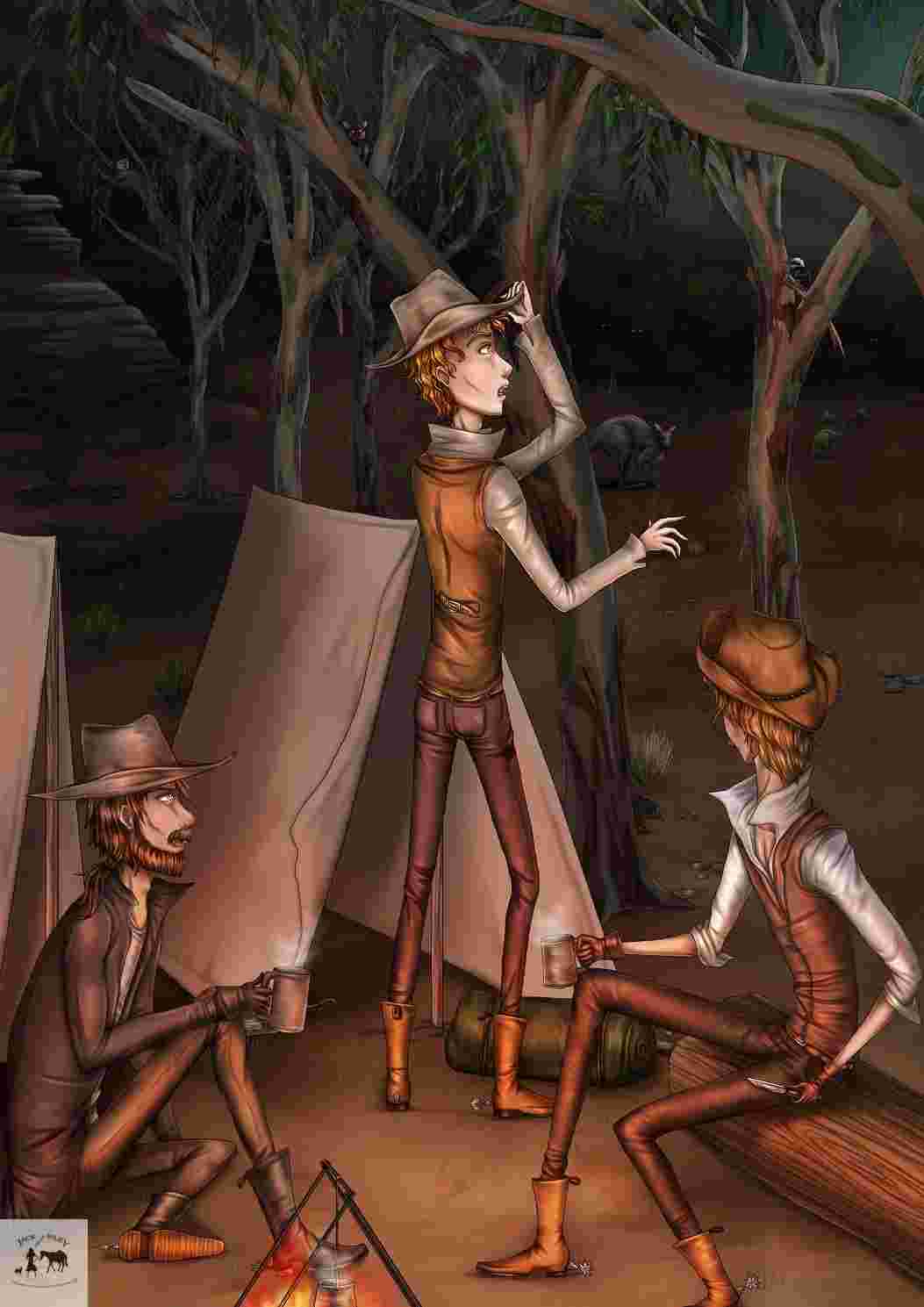
The Story of Jack Riley
Jack’s interest in aboriginals was piqued. The man had appeared so quietly and seemed to just melt away into the bush. It was obvious that he knew it like the back of his hand. The encounter kept Jack wondering. He wondered how aboriginals lived. Where they lived. And why the one he encountered seemed to know the bush so intimately. Jack’s mates didn’t share his interest. They’d seen aboriginals many times, and they didn’t ask questions about their history or their treatment.
The Ballad of Jack Riley
Emerging out of the earth comes this original man
Awakening a sense of mystery, mystery long forgotten
Emerging out of the earth comes this original man
The original man piqued Jack’s interest in the land
Emerging out of the earth comes this original man
Touching something deep inside
Emerging out of the earth comes this original man
Once forgotten, mystery is now strangely familiar
He rides for you, and he rides for me
He rides for you, and he rides for me
Events
Scene 16
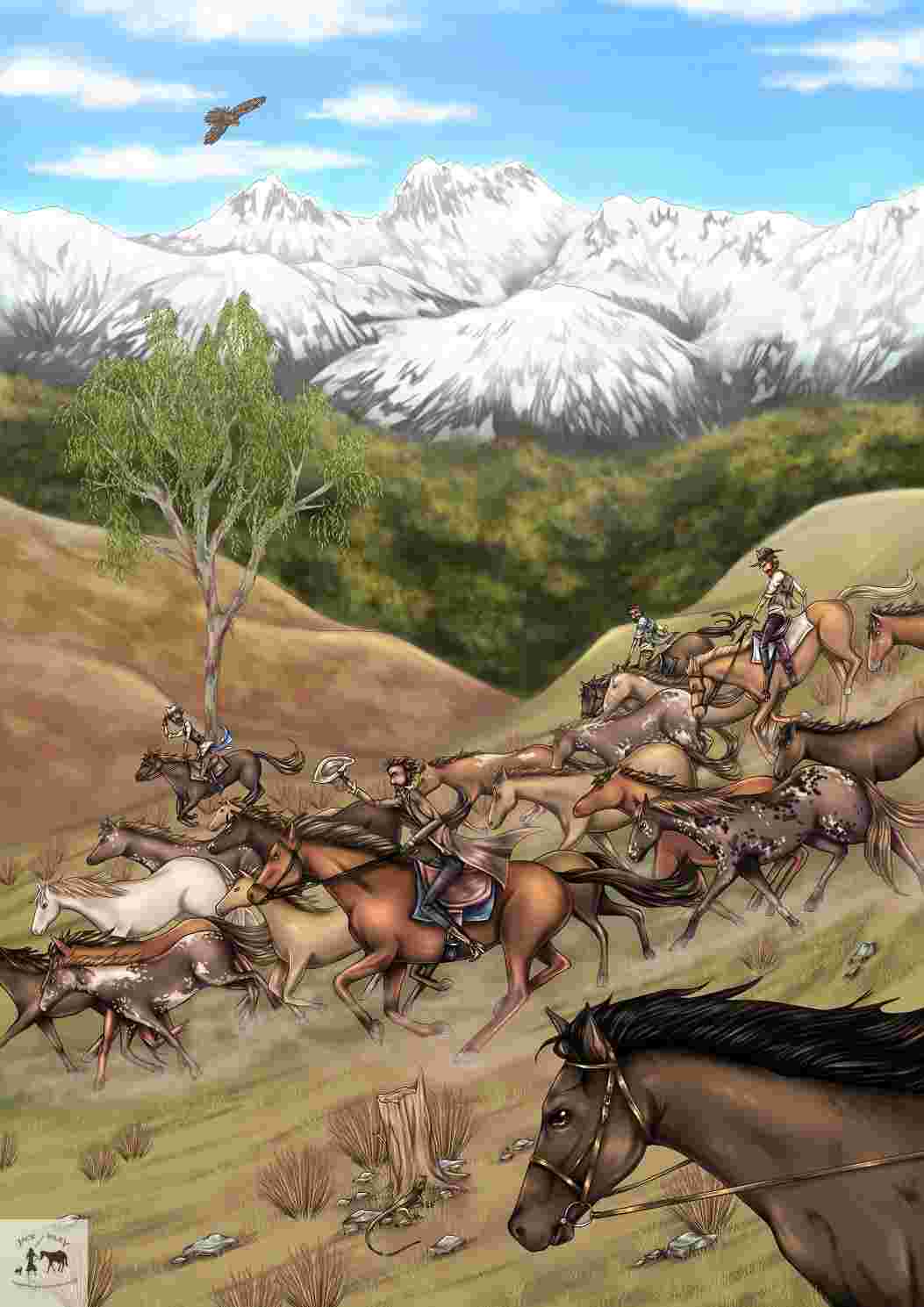
The Story of Jack Riley
After his sister remarried again, Jack left tailoring to pursue the life of a bushman and stockman. He had loved horses ever since he was a tiny lad in Ireland. He had an affinity with them, and horses became a big part of his life. He worked in the Monaro district for the Prendergast and Freebody families, and at a station near the border of New South Wales and Victoria. He quickly became known as a mountain rider, horse-breaker, bushman and tracker of wild horses.
The Ballad of Jack Riley
Emerging out of the earth comes this original man
Resisting life on the land became impossible for Jack
Emerging out of the earth comes this original man
He is finding himself mustering horses for the squattocracy with his mates.
Emerging out of the earth comes this original man
The lure of the Australian high country appeared to nurture his soul while the binge drinking with mates intoxicated his body
And so Jack encountered the fourth and fifth horsemen of the apocalypse: anxiously seeking social approval and drug addiction.
He rides for you, and he rides for me
He rides for you, and he rides for me
Events
Duffy Land Act 1862
The Indian Remount market involved supplying horses from ports like Bega in NSW to the British Army in India and was serviced by wild horses from the Australian Alps. In the Irish Catholic communities, from Cooma and the Monaro High Plains in New South Wales to Omeo in Victoria, horse rustling was rife in the supply of this type of market. This stretch of Australia was on the Eastern side of the Australian Alps. While the wild horses, brumbies, might be roaming on unattended and neglected 20,000-acre lease runs, technically, taking these horses was theft. In the 1850s and 1860s, Australia was a sectarian society. However, in general, the division was between the landowners, “the haves”, and the workers on the land, “have-nots”.
Scene 17
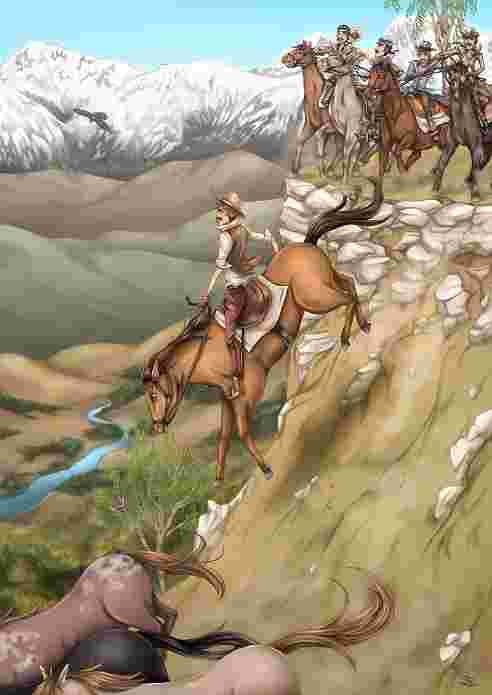
The Story of Jack Riley
One of his exploits was to chase a thoroughbred down a steep mountainside, where his mates dared not follow. Jack’s horse carried him through scrub and tree branches, which blinded Jack while he was pelting down the mountain. In fact, he didn’t even know the thoroughbred had raced into the holding yard until he could see. His face and arms were cut from the branches, and his horse was bleeding from cuts. But he caught that thoroughbred, and that became the basis for Banjo Patterson’s “The Man from Snowy River”, many years later.
The Ballad of Jack Riley
Taking that reckless leap of faith
Jumping into the wild
Taking that reckless leap of faith
A reckless quest to contact mystery again or get high
Taking that reckless leap of faith
Jack was out of control either way
Taking that reckless leap of faith
Seeking something more or acting out some unresolved conflict in extreme risk tasking
He rides for you, and he rides for me
He rides for you, and he rides for me
Events
| Year | Winner of the Melbourne Cup |
| 1870 | Nimblefoot |
| 1871 | The Pearl |
| 1872 | The Quack |
| 1873 | Don Juan |
| 1874 | Haricot |
| 1875 | Wollomai |
| 1876 | Briseis |
| 1877 | Chester |
| 1878 | Calamia |
| 1879 | Darriwell |
Scene 18
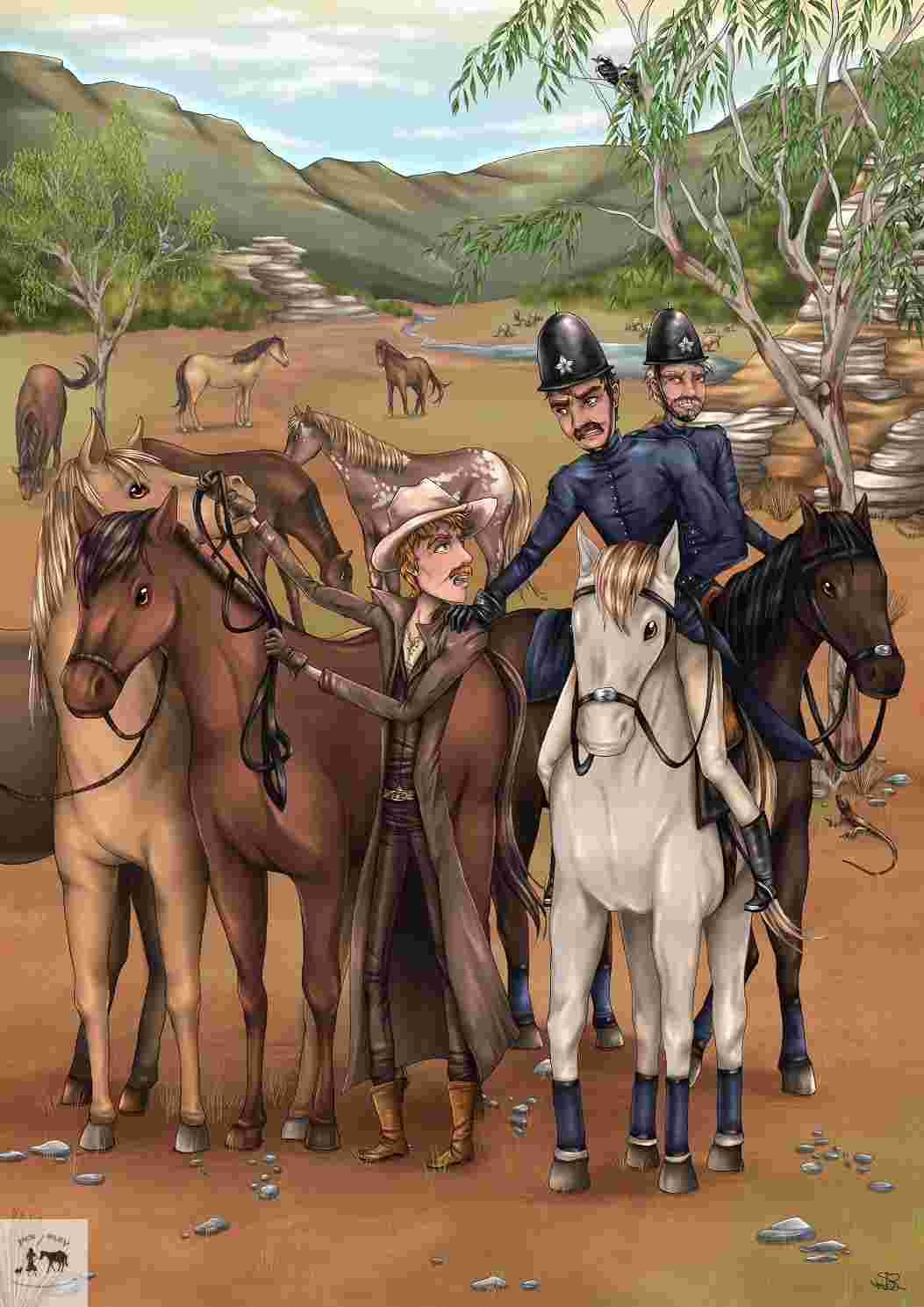
The Story of Jack Riley
Then Jack started mustering horses with his mates – marginalised Irish Catholics from the Cooma, Alps and Monaro Plains region – and felt a sense of freedom and belonging that was unlike anything he’d experienced before. But belonging came at a price. His desire to conform with his group of new mates led Jack to become involved in illegal activities. Soon he was horse rustling, driving stolen horses across the high country and into yards, where they could be sold on to the Indian Remount market. But his days of horse theft came to an abrupt end when the police caught him red-handed with some stolen horses. The force of the law was feared by the horse thieves, and they did their utmost to avoid being caught. The police were very tough on Jack. They sentenced him to gaol. But the thought of being locked up after the freedom he’d enjoyed pulled Jack up with a big mental jolt. He felt hardly done by and became very depressed as the tormenting questions came back to haunt him.
The Ballad of Jack Riley
Living on the edge has its price
For the marginalised or not
Living on the edge has its price
It all catches up one day
Living on the edge has its price
Jack gets nicked
Living on the edge has its price
Nonetheless, Jack is shocked
He rides for you, and he rides for me
He rides for you, and he rides for me
Events
Notable bushrangers of 1851-1870 era Captain Melville; Rocky Whelan; Frank Gardiner; Johnny Gilbert; Ben Hall; Captain Thunderbolt; Daniel Morgan; Harry Power
Scene 19

The Story of Jack Riley
His time in prison was horrible for Jack. He was full of self-loathing. He remembered the traumatic times of the potato famine, with people suffering and dying, and the difficulties he had on the trip out to Australia. Jack became withdrawn and self-pitying. Years ago, he questioned, “Why am I surviving?” during the famine. Now he asked, “Why me?” He did not tell on his mates but took all the blame for stealing horses himself. In his striped prison garb, he made a sad and pathetic figure.
The Ballad of Jack Riley
Soul searching
No grog and no mates to get high with
Soul searching
No wild, risky riding to release tension
Soul searching
Everything outside is still
Soul searching
Inside all is agitating, body and soul in conflict
And so Jack encounters the sixth horseman of the apocalypse: theft.
He rides for you, and he rides for me
He rides for you, and he rides for me
Events
Notable bushrangers of the 1871-1902 era Captain Midnight; Andrew George Scott; Ned Kelly; Johnny Campbell; Paddy Kenniff; Jimmy Governor
Scene 20
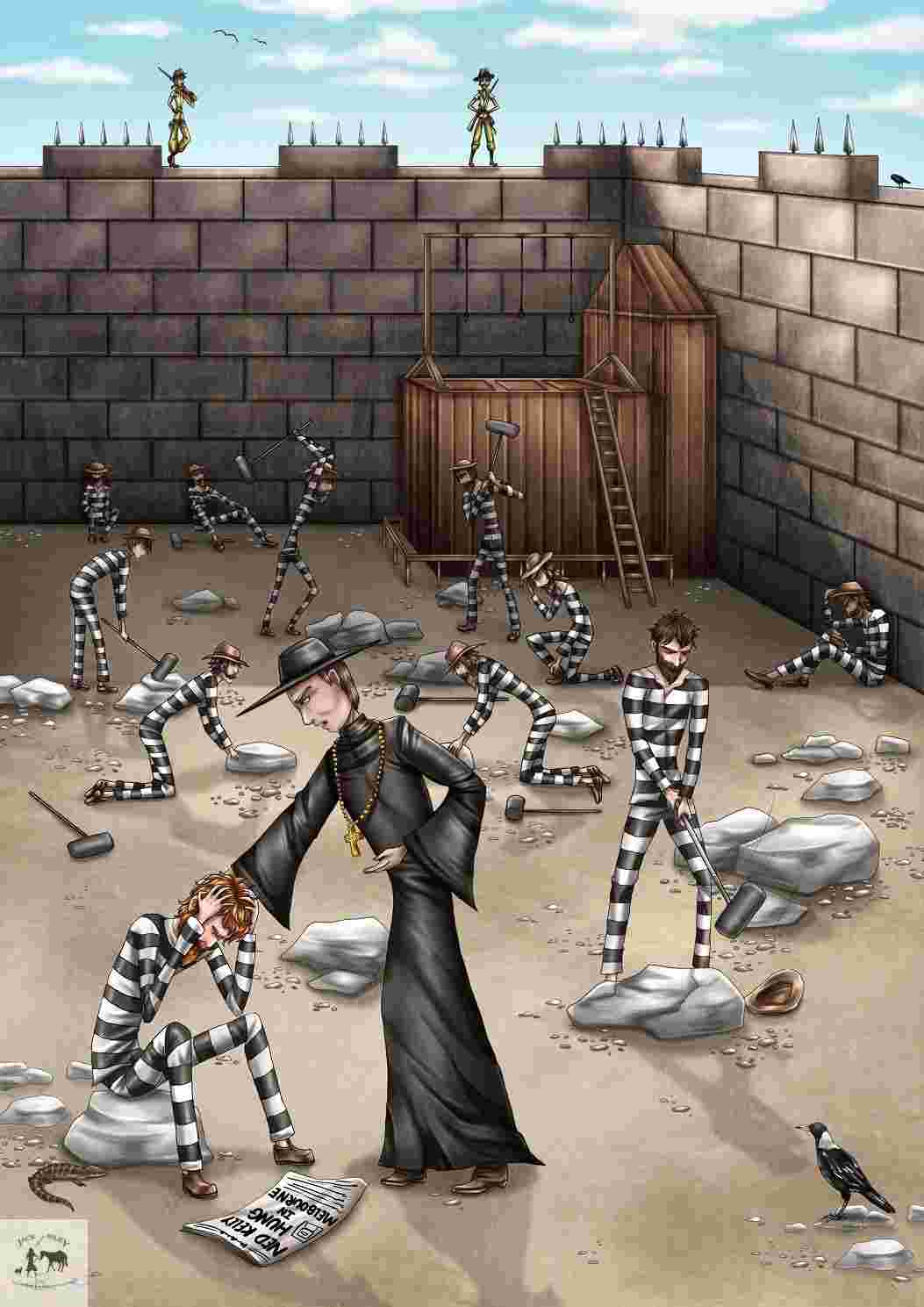
The Story of Jack Riley
One day, a priest visited and gave him hope and a way to find peace. The priest encouraged Jack to follow a better path – to live a life in which crime played no part. He helped Jack realize that the choice he made to fall in with horse thieves was his responsibility. If he made himself accountable, repented, and changed his ways, then God’s forgiveness would be his. Jack felt relief and a renewed spirit. He knew in his heart that this was what he needed to hear. It set him on a straight course, and when he was released from gaol, he determined to live by his faith in God’s mercy. He felt freed from the compulsive need for social acceptance by the ‘mates’ that had been a bad influence on him
The Ballad of Jack Riley
Finding a way out of one life into another.
Now, what is a priest?
Finding a way out of one life into another.
What is his value?
Finding a way out of one life into another.
Jack reconnects with the church
Finding a way out of one life into another.
Jack reconnects with his soul
He rides for you, and he rides for me
He rides for you, and he rides for me
Events
| Year | Winner of the Melbourne Cup |
| 1800 | Grand Flaneur |
| 1881 | Zulu |
| 1882 | The Assyrian |
| 1883 | Marini-Henri |
| 1884 | Malua |
| 1885 | Sheet Anchor |
| 1886 | Jarsenal |
| 1887 | Dunlop |
| 1888 | Mentor |
| 1889 | Bravo |
Scene 21
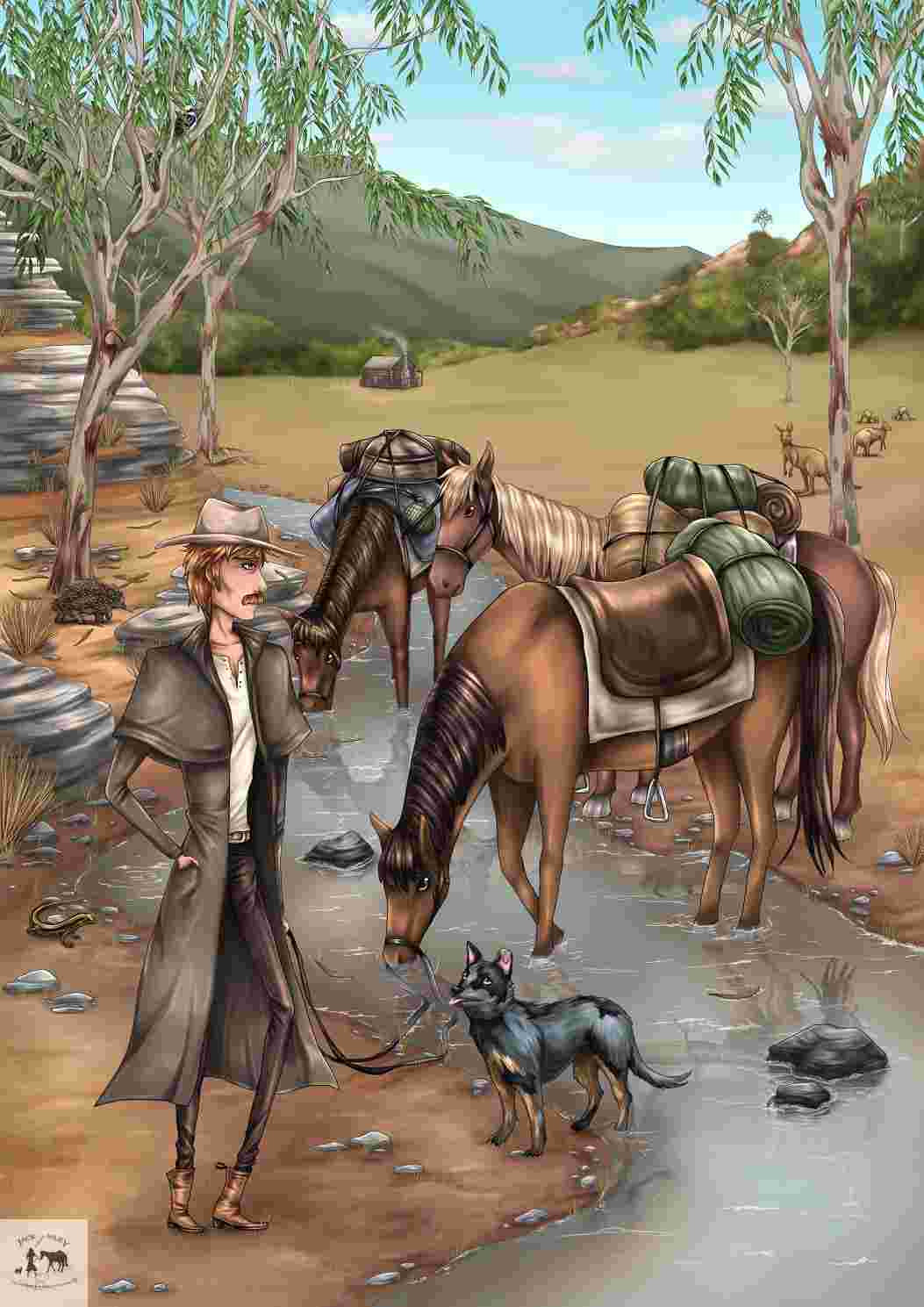
The Story of Jack Riley
Jack began to look deep inside to find solitude and peace of mind, self-acceptance and mindfulness. And he continued with his quest to live with the open question, why am I surviving ? which had haunted him from childhood. He became a reliable stockman, spending much of each year in the beautiful high country, around the Snowy River, and the Victorian and New South Wales border near Tom Groggin. When he needed supplies, he’d head for Omeo, and catch up with his mates, his sister, now at Cassilis, over 10 miles from Omeo, and her children. And of course, being a master storyteller, Jack spun yarns.“See here, now”, he’d start. And his nephews and nieces would listen to him with wonder in their eyes, and his sister would hang on every word. Jack was a hero to them, and they relished every one of his visits.
The Ballad of Jack Riley
The stilling yet the disturbing question remains
Communing with the Australian high country in solitude, Jack finds peace of mind and self-respect
The stilling yet the disturbing question remains
While communing with the Australian high country, the open question:‘why am I surviving’? is no longer overwhelming but rather a foundation for contemplation, wonder and awe.
And so Jack encounters the seventh horseman of the apocalypse: treating isolation and the delusion of not needing others as a comfort zone
He rides for you, and he rides for me
He rides for you, and he rides for me
Events
Ned Kelly hung in 1880 in Melbourne, marking the end of the bushranger period, 1835 -1880. Jack Riley lives at Tom Groggin 1884 -1914 While Ned Kelly took a violent road to deal with oppression, Jack Riley decided to go the way of peace and lived the last 30 years of his life at Tom Groggin cattle run after jail from 1884. ‘Tom Groggin’ is a transliteration of an old Aboriginal word, ‘tomarogin’, that referred to a water spider that lived in the upper reaches of the Murray River
Scene 22

The Story of Jack Riley
By this time, Jack was 43, and his reputation as a fearless and dashing rider scored him a job as a stockman and caretaker for John Pierce, supervising cattle in the high country. The Pierce family owned and held leases (cattle runs)of 20,000 acres of land, one being at Tom Groggin, west of the main range of the Snowy Mountains. There he lived for the next thirty years. Jack loved the lifestyle and the country. His knowledge of the area was prodigious, and he was well known. He lived in a simple timber hut in the high country. One day, the aboriginal he met years ago reappeared. He told Jack about how his people had been killed and wounded by the white people.
The Ballad of Jack Riley
Breaking into Jack’s comfort zone
Suddenly a different communion breaks into Jack’s space
Breaking into
Jack’s comfort zone Jack is confronted by difference again
Breaking into Jack’s comfort zone
However, this time Jack is more open and receptive to difference.
Breaking into Jack’s comfort zone
Jack is more open to the original man
Breaking into Jack’s comfort zone
More open to 70,000 years of experience of this land, Australia.
He rides for you, and he rides for me
He rides for you, and he rides for me
Events
Scene 23
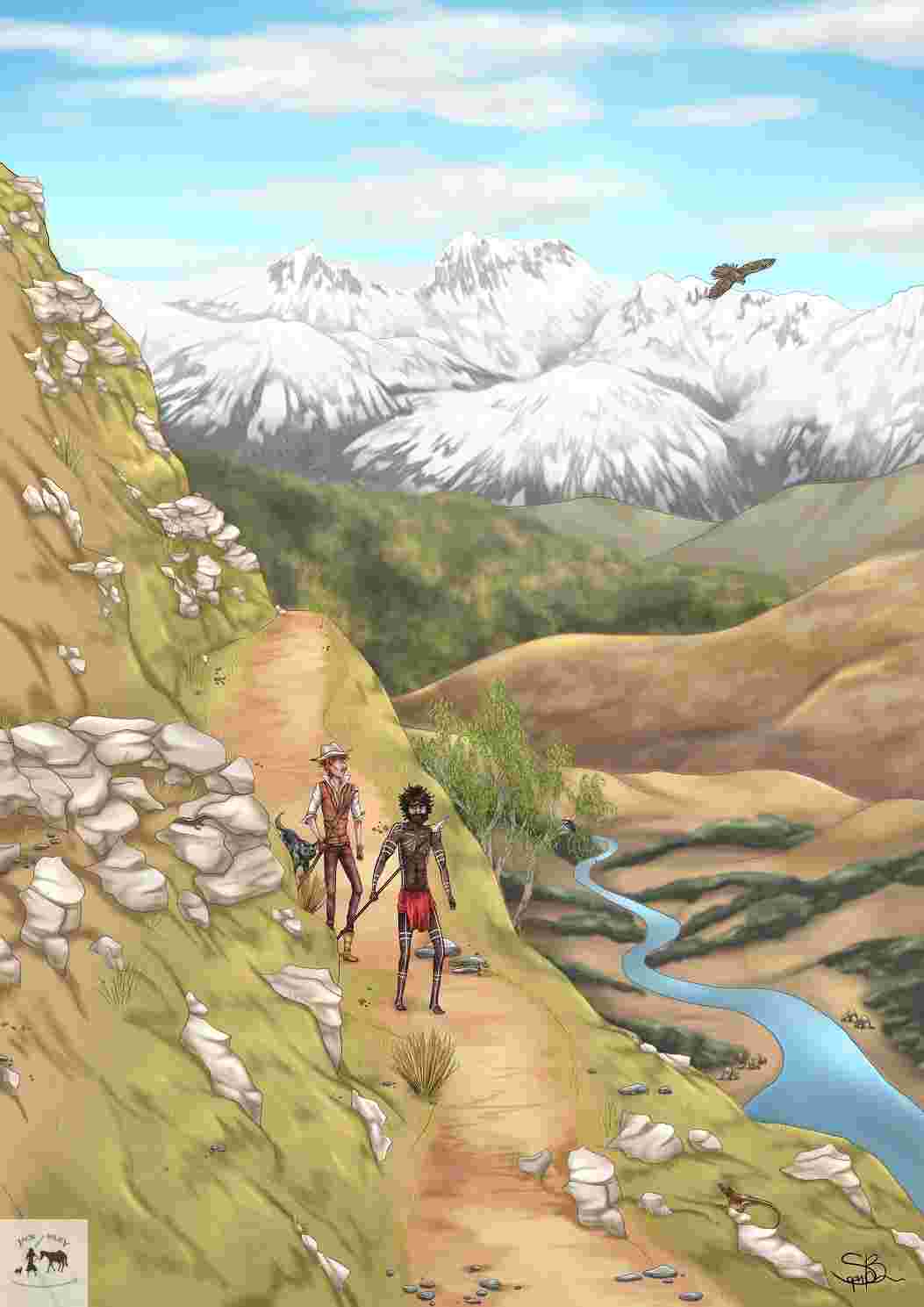
The Story of Jack Riley
He led Jack along a path down from the Snowy Mountains, alongside a river fed by the snow. He felt instinctively that Jack was different. That he was compassionate. And that he had suffered too. Jack trusted his companion and wanted to see for himself what terrible things had been done to his people. A Wedge-Tailed Eagle was circling overhead as like it was protecting and blessing the pair on their long journey to the aboriginal settlement. Jack discovered a new type of mateship, one that was free of compulsions to please. One based on something deeper and calmer.
The Ballad of Jack Riley
Following the original man down the mountain
Jack descends into the original man’s soul
Following the original man down the mountain
Jack descends into his own soul
Following the original man down the mountain
Jack descends into an open space in his mind, a space for God
Following the original man down the mountain
Jack descends into his transcendent open question again: Why am I surviving?
He rides for you, and he rides for me
He rides for you, and he rides for me
Events
Scene 24
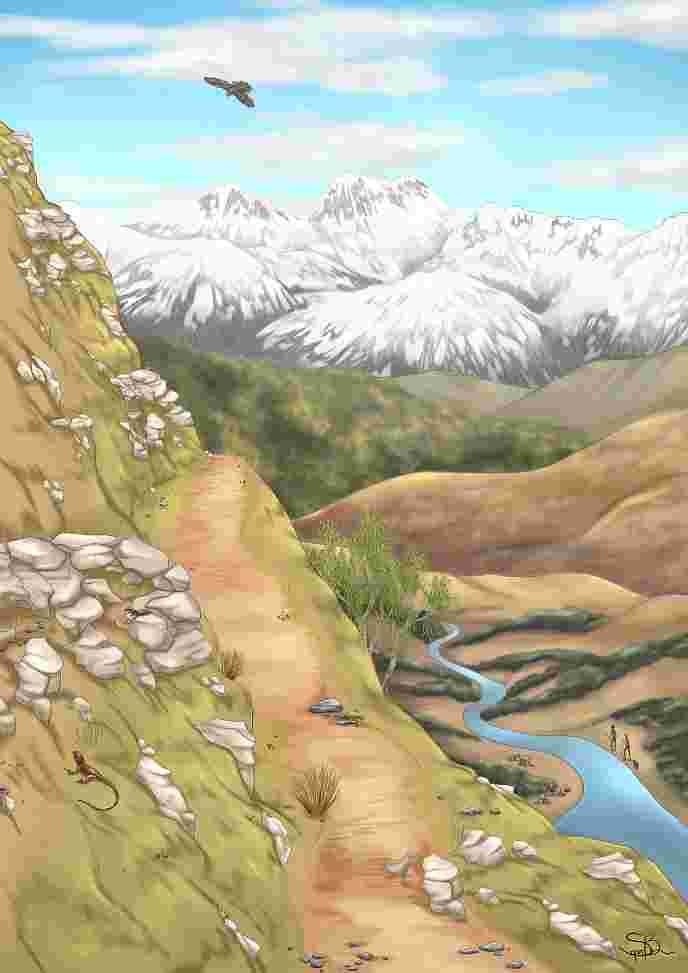
The Story of Jack Riley
It was slow going, even downhill. Jack and his aboriginal guide kept to the long, winding path that was narrow in parts and in danger of rockfalls in others. And always overhead, the eagle kept circling, watching and crying its series of high-pitched notes. The guide was a man of few words, and Jack walked with him, silently, watching and trying to prepare himself for what lay ahead. As the guide walked down the path, he seemed attentive to the elements and attuned to the earth. Eventually, after following the path far down from the Snowy Mountains, and crossing the river in parts, Jack and his aboriginal guide arrived at what had once been a happy settlement.
The Ballad of Jack Riley
Following the original man even further down the mountain
Jack became mindful of his attentiveness to the immediate environment
Following the original man even further down the mountain
Jack became mindful of his presence of mind
Following the original man even further down the mountain
Jack became one and equal with the original man
He rides for you, and he rides for me
He rides for you, and he rides for me
Events
Scene 25
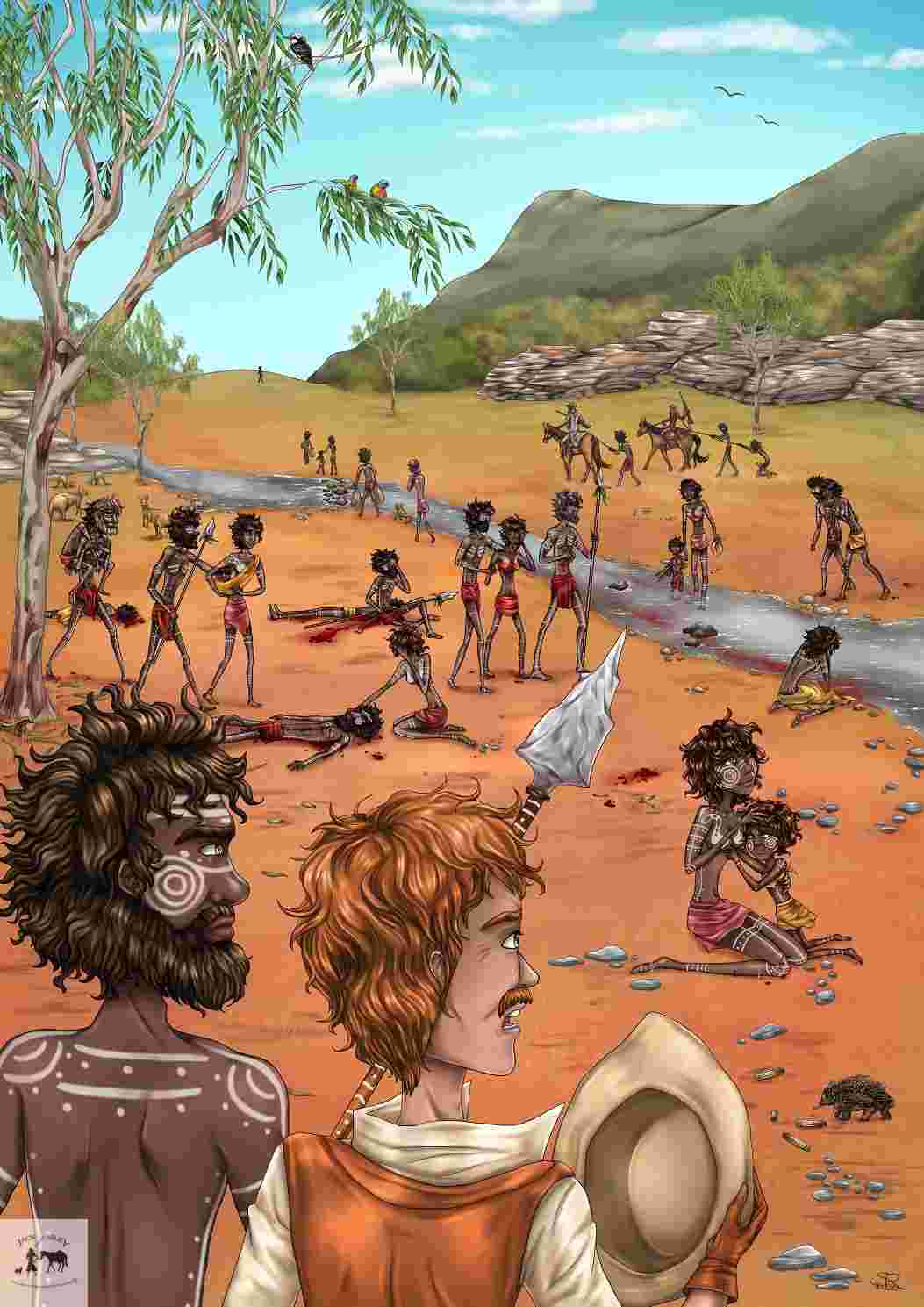
The Story of Jack Riley
Jack was faced with a truly terrible scene. European colonists on horseback had shot and killed most of the aboriginals, and many were badly wounded and dying. Blood ran red on the red earth. Mothers cradled their dying children, tears running down their cheeks. Everywhere was sorrow, horror and untold misery. The white men were merciless, massacring these innocent indigenous people to get them off their land so they could steal that land for themselves. In an instant, years of fighting his mind caved in as the scene opened the demons in Jack’s mind, breaching his defences, and it seemed that he’d never escape his past.
The Ballad of Jack Riley
Arriving as one at the massacre scene
The two are equal and of one origin
Arriving as one at the massacre scene
Jack and the original man are one
Arriving as one at the massacre scene
The two are equal and of one origin
Arriving as one at the massacre scene
Common suffering bonds them deeply
Arriving as one at the massacre scene
Common oppression binds them as “have nots” against “the haves”, the squattocracy.
Arriving as one at the massacre scene
They are in solidarity for a just cause
He rides for you, and he rides for me
He rides for you, and he rides for me
Events
Hospital Creek, Brewarinna
| Site Name | Hospital Creek, Brewarinna |
| Victims | 400 Aboriginal People killed |
| Attackers | 0 Colonists killed |
| Date range | Between 1870-01-01 and 1870-12-31 |
| Language Group | Pooncarie/Parkantyi |
Scene 26
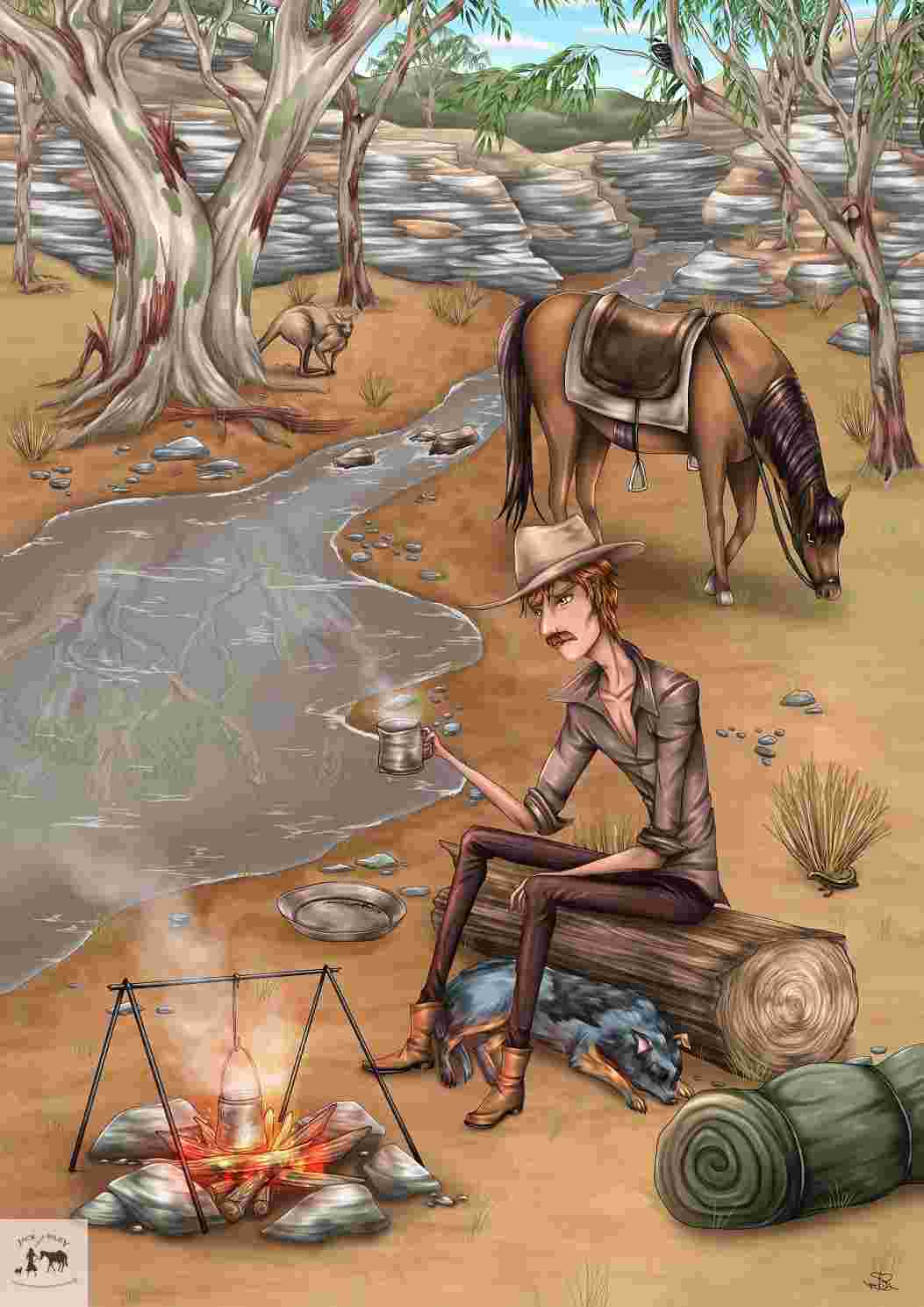
The Story of Jack Riley
Jack returned to his mountain home. There he considered all that he’d seen, from his early years in Ireland and the famine, to the massacre of the aboriginals so their land could be stolen. Jack spent many hours deep in thought, by his campfire, accompanied by his trusty steed, his dog and a nip or two of whisky. He made the decision to be compassionate and non-judgmental to others, to help where he could, to live a life that was honest and open. It was an epiphany. He saw that by being open-minded and never judgemental, he could be a positive influence. It was as if the demons poured out of his mind and into the ether. He felt free and filled with the Spirit of a merciful God.
The Ballad of Jack Riley
Contemplating, Jack sits beside the Snowy River
Now Jack is one with the original man
Contemplating, Jack sits beside the Snowy River
Jack is the original man now
Contemplating, Jack sits beside the Snowy River
Jack is the original man from Snowy River
Contemplating, Jack sits beside the Snowy River
Jack rides with the message stick like a baton from the original man
He rides for you, and he rides for me
He rides for you, and he rides for me
Events
Scene 27
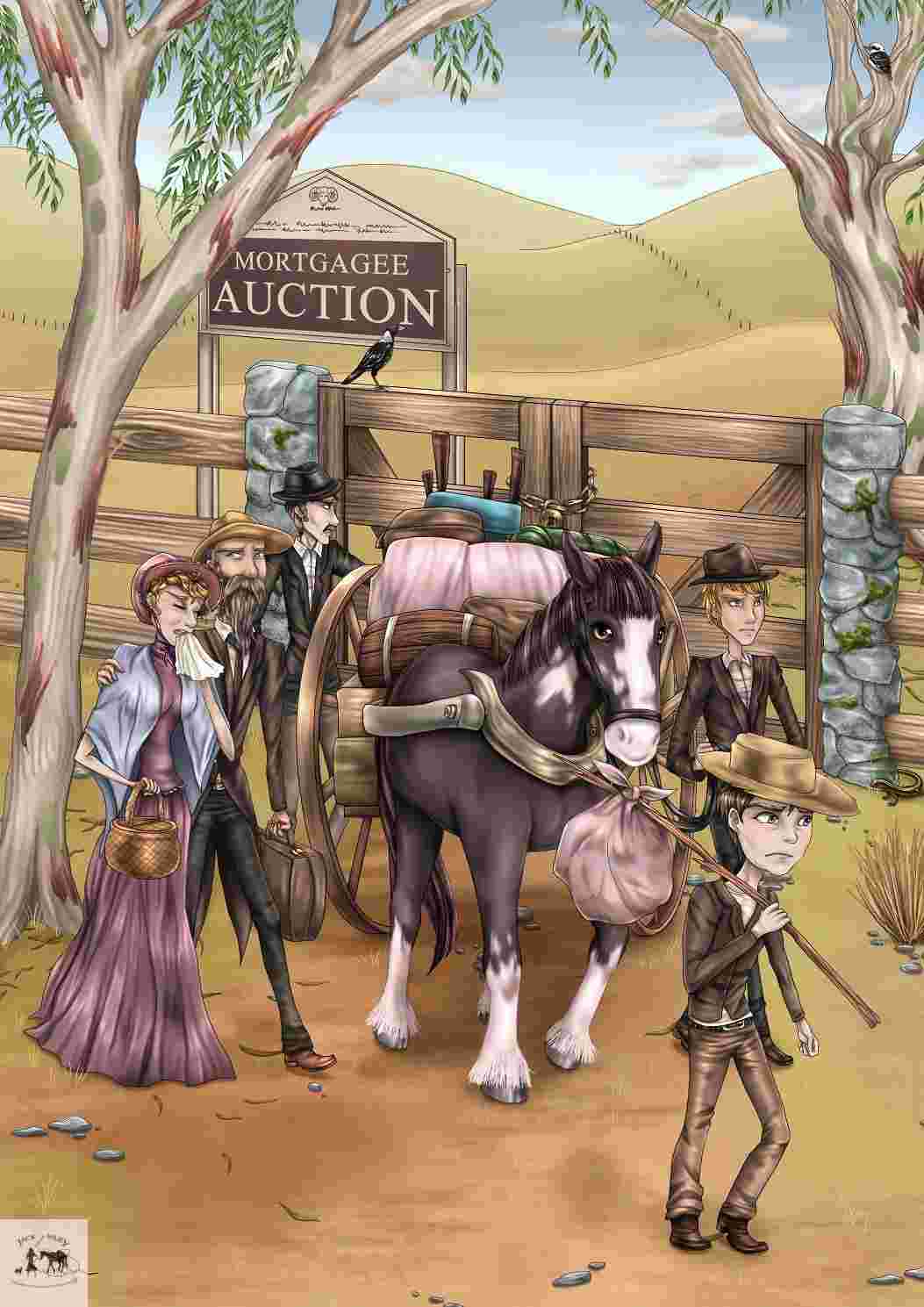
The Story of Jack Riley
When Andrew Barton ‘Banjo’ Paterson was just five years old, his father lost his wool clip in a flood and was forced to sell up. His family took over an uncle’s farm near Yass. Banjo was forever bonded with those less fortunate because of his family’s tragedy. The young Banjo saw Cobb and Co coaches and drovers. And he also saw horsemen from the Murrumbidgee River and the Snowy Mountains country. His fondness for horses and the high country inspired his writing. Banjo was a solicitor in Sydney in the late 1880s, and he penned many well-known poems and the song Waltzing Matilda, which was for years the Australian National Anthem.
The Ballad of Jack Riley
Banjo lost everything too as a child
Banjo’s family lost everything in a flood
Banjo lost everything too as a child
The wool clip lost in a flood
Banjo lost everything too as a child
Banjo learnt to see the selectors’ plight
Banjo lost everything too as a child
Banjo saw the way of the “have nots”
Banjo lost everything too as a child
He is in solidarity with the underdog for a just cause
Banjo lost everything too as a child
Banjo, lawyer, journalist and poet was for the selectors seeking justice and survival on the land.
He rides for you, and he rides for me
He rides for you, and he rides for me
Events
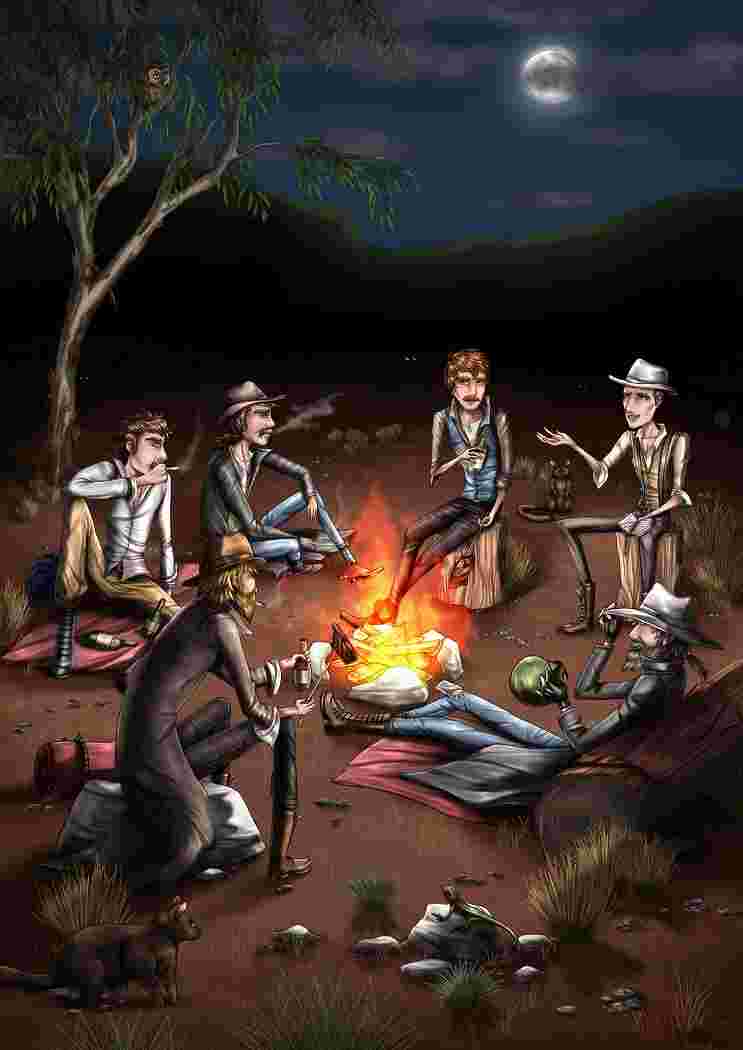
The Story of Jack Riley
In the summer of 1889 to 1890, Banjo visited two brothers on an Upper Murray property. The Mitchell brothers, with whom he’d gone to King’s College in Sydney, took Banjo up into the mountains, passing through Tom Groggin, where they stayed the night with Jack. Round the campfire, they shared a bottle of whisky. Then Jack began to regale them with some of his exploits as a stockman in the high country. “See here, now”. He told them of the time he chased the thoroughbred down the mountain, through thick scrub and tree branches that almost blinded him. Banjo was fascinated, and his mind saw a story in this. Three months after meeting Jack, he published “The Man from Snowy River” in Sydney’s Bulletin, showing the triumph of the underdog over the expectations and prejudices of others.
The Ballad of Jack Riley
Handing the message stick from the original man to Banjo
The Irish blarney returns
Handing the message stick from the original man to Banjo
It returns with a new message
Handing the message stick from the original man to Banjo
A message of recognition for the underdog
Handing the message stick from the original man to Banjo
Heralding the emerging egalitarian Australian identity
He rides for you, and he rides for me
He rides for you, and he rides for me
Events
| Year | Winner of the Melbourne Cup |
| 1890 | Carbine |
| 1891 | Malvolio |
| 1892 | Glenloth |
| 1893 | Tarcoola |
| 1894 | Patron |
| 1895 | Auraria |
| 1896 | Newhaven |
| 1897 | Gauius |
| 1898 | The Graft |
| 1899 | Merriwee |
Scene 29
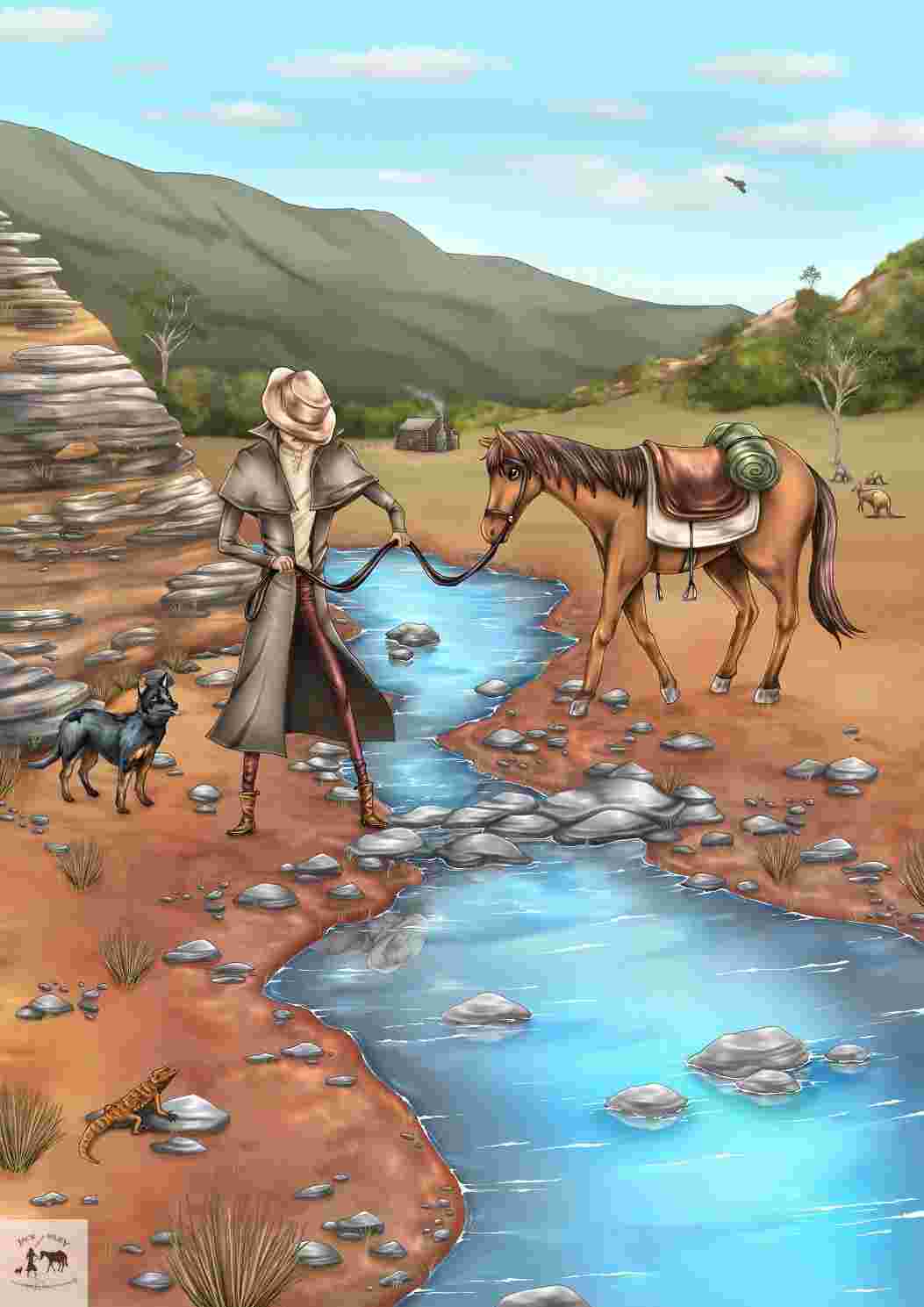
The Story of Jack Riley
Jack lived a solitary life in his simple hut in the Snowy Mountains. As well as his work, he was also a guide to those who required his services, and he welcomed visitors. Even those tourists who earlier eschewed his offer of help in their travels, but then came to grief because their compass let them down, encountered nothing but goodwill and hospitality from Jack. He became a legendary figure in the bush, lauded for his generous and hospitable nature. And a glass of whisky was never far away. The years rolled on, and on. Jack was no longer young and agile. His hard life, and the burden of his constant questioning, took their toll.
The Ballad of Jack Riley
Strangely the question seemed to die
Jack was less troubled now by the open question: Why am I surviving?
Strangely the question seemed to die
Having handed the message stick to Banjo
Strangely the question seemed to die
Released from his mission for Australia
Strangely the question seemed to die
Jack had this pervasive sense of mission accomplished
He rides for you, and he rides for me
He rides for you, and he rides for me
Events
| Year | Winner of the Melbourne Cup |
| 1900 | Clean Sweep |
| 1901 | Revenue |
| 1902 | The Victory |
| 1903 | Lord Cardigan |
| 1904 | Acrasia |
| 1905 | Blue Spec |
| 1906 | Poseidon |
| 1907 | Apologue |
| 1908 | Lord Nolan |
| 1909 | Prince Foote |
Scene 30
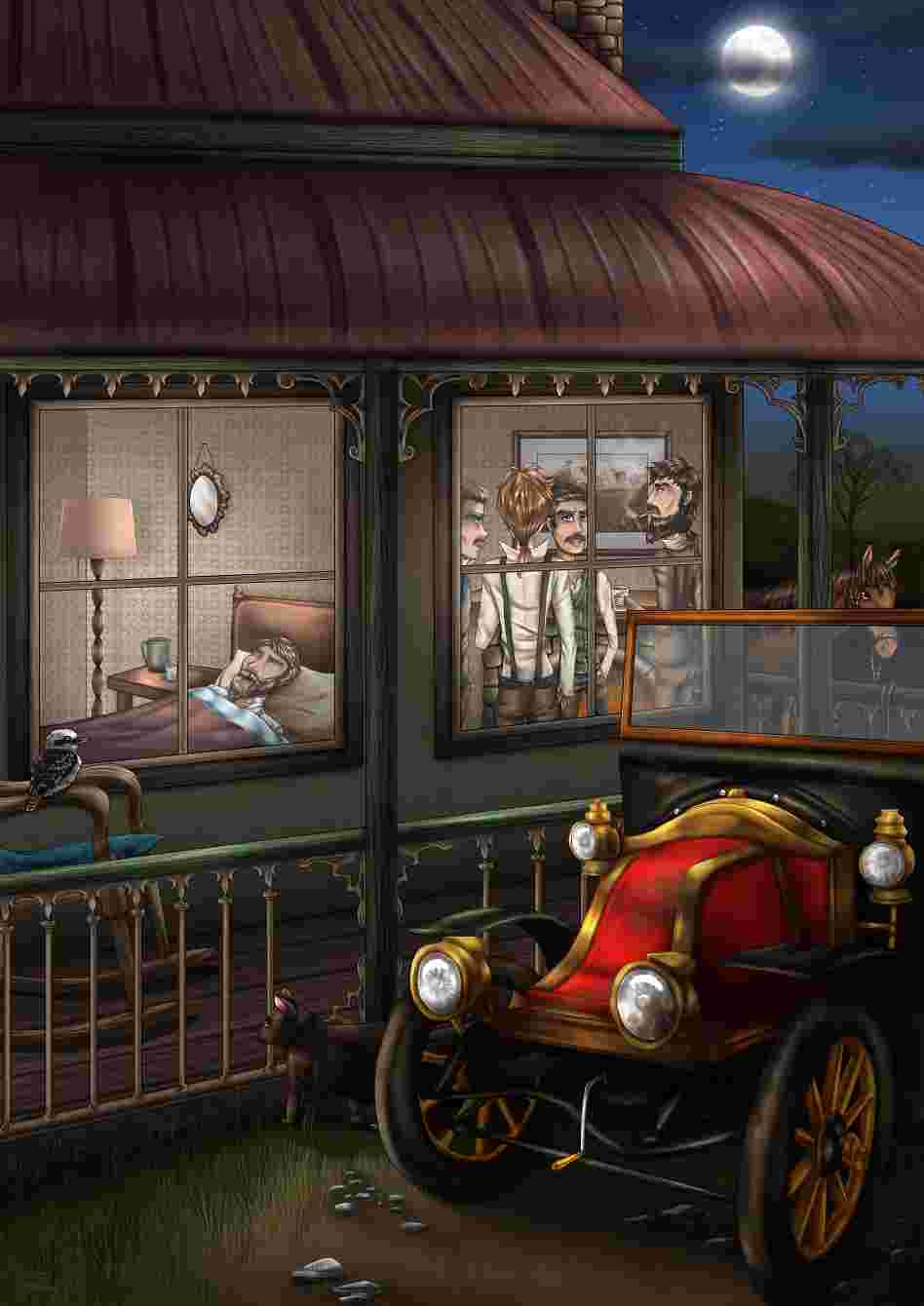
The Story of Jack Riley
In 1911, Jack was 70. He’d had a hard life, but a good one, in his beloved Snowy Mountain hut at Tom Groggin. But he continued to search for the answers to his questions about being spared during the Irish famine. Jack became very ill, and it was feared by those who knew him that his end was nigh. He was taken to the Station House at Khancoban in New South Wales, where he lay in bed. The priest, Father Patrick Joseph Hartigan, was summoned, to give Jack his Last Rites.
The Ballad of Jack Riley
Waiting in silence
While his mates chatter next door
Waiting in silence
While a horseless carriage pulls up
Waiting in silence
While questions return, filling in the space
Waiting in silence
While he waits to reconnect with the church before he passes
He rides for you, and he rides for me
He rides for you, and he rides for me
Events
Scene 31
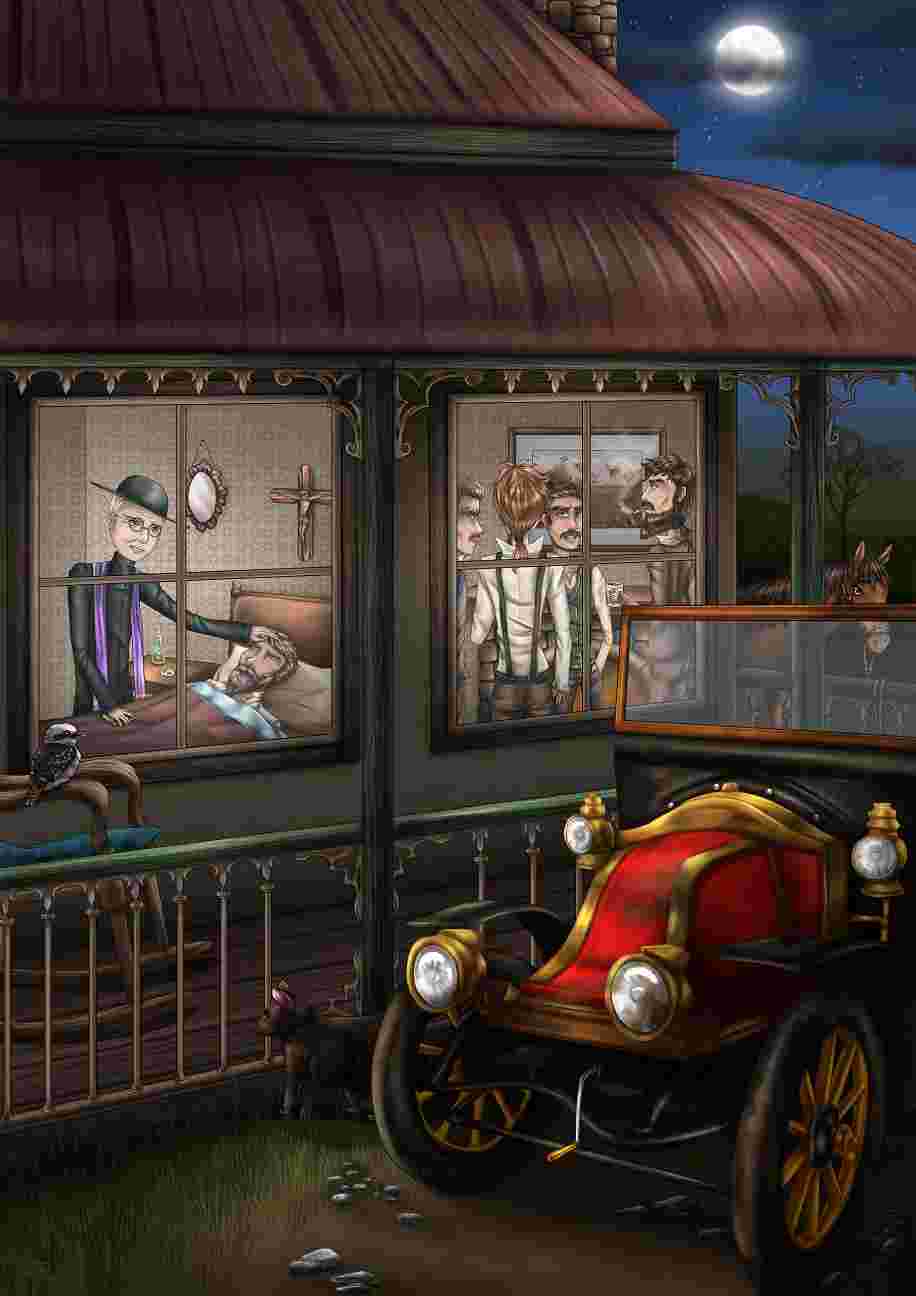
The Story of Jack Riley
Father Hartigan arrived in his early model Peugeot. He was one of the first curates in the state to have a car. As he went in to give Jack the Last Rites, Jack asked him why he’d been spared during the terrible potato famine in Ireland. Father Hartigan encouraged Jack to find meaning in his life through faith in a merciful God. He realised then that he’d been on a journey to help and benefit others – the Australian people. He was spared because it was his destiny to live here in Australia and to show kindness and compassion to others, and create an emblematic pathway of peace, forgiveness and mateship. Jack was touched. The Last Rites over, he went on to improve, and before long, he was back in his beloved Snowy Mountains hut.
The Ballad of Jack Riley
The returning priest comes to bless Jack’s final ride
Jack is filled with the knowledge of the love of a forgiving God
The returning priest comes to bless Jack’s final ride
Jack is filled with peace of mind
The returning priest comes to bless Jack’s final ride
Jack’s questions no longer
The returning priest comes to bless Jack’s final ride
Jack is one with his church, his country and himself
He rides for you, and he rides for me
He rides for you, and he rides for me
Events
Scene 32
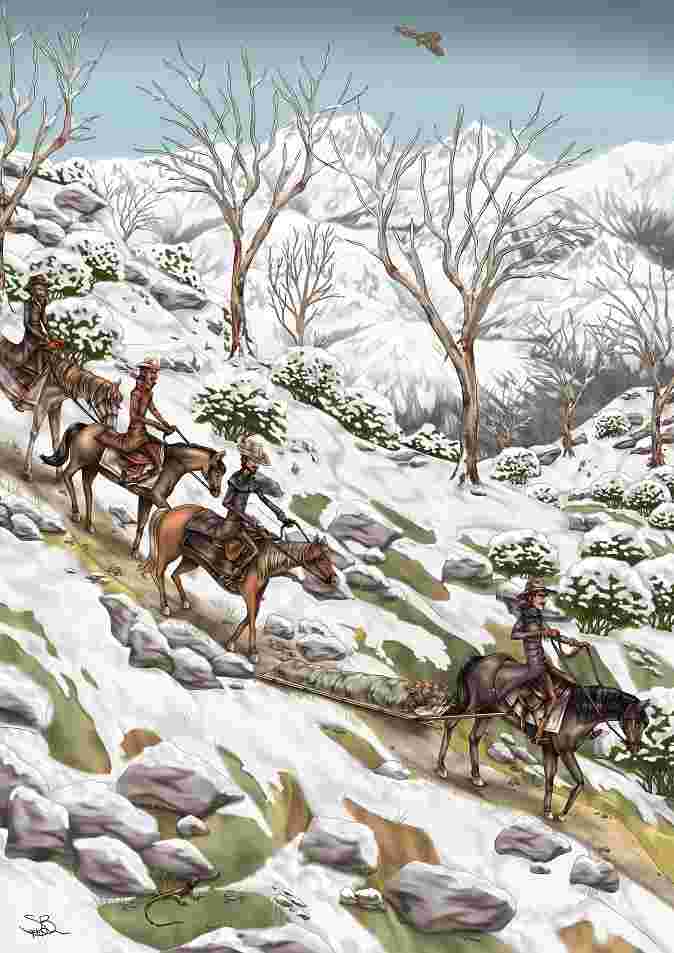
The Story of Jack Riley
But several years later, in the freezing winter of 1914, word got out by his mates that Jack was seriously ill. A guide and four of Jack’s friends arrived at Jack’s hut with equipment and a stretcher, to take Jack to the Corryong Hospital. Jack was frail and very ill, and after he was strapped onto the stretcher, they began the slow and taxing journey on foot to Corryong. For several miles they made good time. But when they had to climb out of the gorge and over the shoulder of Hermit Hill, ascending over 2,000 feet, the stretcher could not be used. So they put Jack on a horse, with the lightest of his friends sitting behind him to hold him steady. Friends took each side to support a barely conscious Jack, while the snow began to fall and bitter cold enveloped them.
The Ballad of Jack Riley
Surrendering to time
Jack’s body is surrendering to time
Surrendering to time
Jack’s mates carry him down
Surrendering to time
Warm mateship in the freezing cold
Surrendering to time
The end is nigh for the legend of the Upper Murray
He rides for you, and he rides for me
He rides for you, and he rides for me
Events
| Year | Winner of the Melbourne Cup |
| 1910 | Comedy King |
| 1911 | The Parisian |
| 1912 | Piastre |
| 1913 | Postinatus |
| 1914 | Kingsburgh |
Scene 33
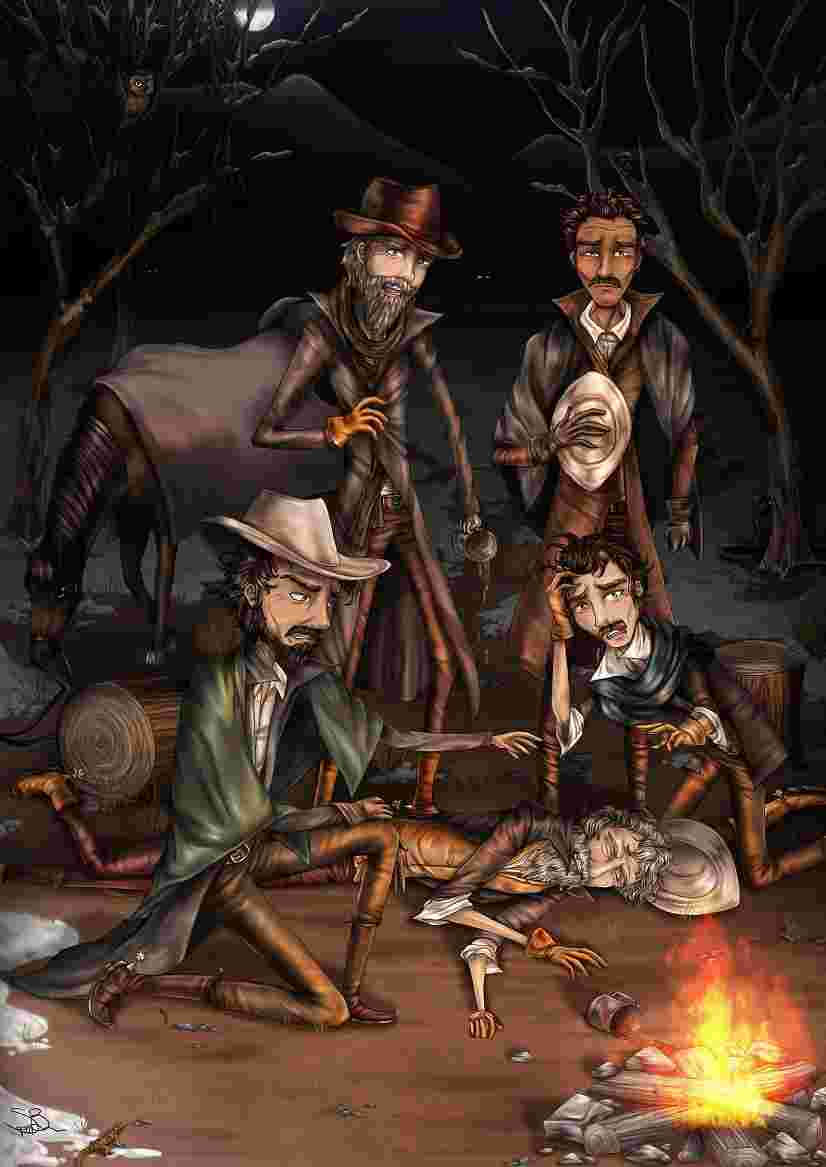
The Story of Jack Riley
Then they put Jack back on the stretcher and carried him to Surveyor’s Creek Junction, where they sheltered in a deserted mining hut and lit a fire to warm him. His friends made Jack as comfortable as possible, and he seemed to rally a little. They held out hope that help would come in the morning and Jack could get hospital care. But that wasn’t to be. After speaking to his friends, his amazing friends, who without question, travelled through the rugged country in the middle of winter to bring Jack to Corryong, Jack leaned a little towards the fire, and said, “I am cold”. Then his heart gave out. He died in the part of the world he loved, with the rain on the roof, the wind in the trees, surrounded by his friends. The Man from Snowy River went on his last, most important, ride.
The Ballad of Jack Riley
Giving up his soul
‘Round the fire
Giving up his soul
Jack is with his mates
Giving up his soul
Jack final words: I am cold
Giving up his soul
Jack falls to the earth as his soul ascends
He rides for you, and he rides for me
He rides for you, and he rides for me
Events
In incubation since 1788 through the tyranny of distance, the uniquely Australian culture and identity of egalitarianism engaged the world en masse through WW1 in 1914. In 1914, Jack Riley died having accomplished his mission.
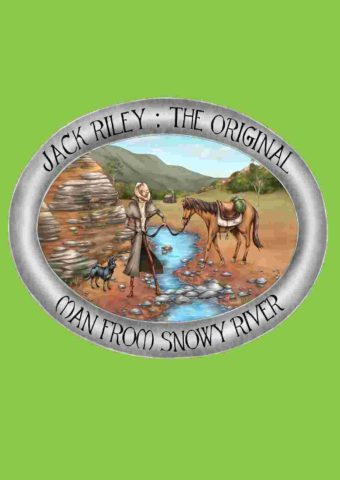
Jack Riley’s spirit thrives in the Upper Murray. Immortalized in the poem, ‘The Man from Snowy River, he is the quintessential Australian hero, emerging out of poverty in Ireland, riding into our hearts and souls.He rides for you and he rides for me. He does not tire. His resolve is sure, his purpose clear. By night he pierces through the moonlit darkness a speed.
He cuts a swath through the grassy high plans and tenaciously climbs rugged mountains to protect and serve while we sleep. By day he sits astride his fearless horse watching over us as we journey. If you are listening carefully as you travel through the Upper Murray and the Australian Alps you will hear the kookaburra and galah singing his praise with delight while the kangaroos, wallabies and bandicoot follow his track in harmonious accord. He has learned to love the Dreaming of the first people of this land. He carries forth the spirit of an ancient land so we who are diverse and many can journey together as one Australia.
A must-have Jack Riley poster, celebrating the 100th anniversary of his death in 1914. The scene depicts Jack and some of his friends yarning around a camp fire with Banjo Paterson. It was this meeting in the late 1880s that inspired Banjo to write “The Man from Snowy River”. Jack is the quintessential Australian hero, emerging from the dire famine in Ireland to ride into our hearts and souls. Although Jack’s life was solitary, he loved visitors and to share stories, always with his lead in words of “See here, now”. He also learnt to love the Dreaming of the first people, and carried the spirit of this ancient land, along with his deep love for the high country, until his dying day. The poster is A1 size (594 x 841mm) Order this poster from https://jackriley.com/ for just $25 plus P&H.
